1. Software Introduction
1.1 Area Overview
Hello, welcome to Found, a digital asset management solution designed for visual creatives. Found aggregates multiple functions, making your design work more convenient and efficient.
[UI] The software panel is divided into three areas based on their functions: [Sidebar] [Main Browser Area] [Preview Panel]

[Software Introduction Video] Click the link to learn about Found's features https://www.youtube.com/watch?v=QUN1MUFMjzU
[1 Minute Overview of Features] https://www.youtube.com/watch?v=G_I8Q-mvUQk
1.2 Switching Between Horizontal and Vertical Layouts
If your display requires a vertical preview, you can change the panel arrangement by clicking the window toggle button next to your account avatar.

Horizontal and vertical interface preview

1.3 Software Login Status
Found supports anonymous device login, allowing you to use most features without logging in. For example, in anonymous mode, you can still use the Collection feature but cannot share, and some functions will be limited.
After registering and logging in, you can choose to migrate collections created in anonymous device mode to that account. Collection data under different logged-in accounts will not be shared on the same device.
1.3.1 Offline Use
Found currently supports short-term offline use. Pro users can continue to use all professional features for up to 48 hours after the network is completely disconnected, while non-Pro users can use it for up to 12 hours after the network is completely disconnected. The timer resets when reconnecting to the network. Found only performs login information checks during network connection and will not actively obtain any of your file information. If you need to use it in a long-term offline environment, please contact us [for a customized enterprise version (jump to contact us)].
1.3.2 Anonymous Device Mode and Logged-in Status
When the login window pops up, you can choose to close it directly. The next time you open Found, it will automatically enter anonymous device mode. Some features may be limited in anonymous mode, so we recommend free registration and login to access more features. If you created multiple collections in anonymous mode, when you log in with a new account, you will be asked if you want to migrate these collections to that account.

2. Sidebar
The [Sidebar] is where you quickly select files to open, save frequently used paths, and create [Collection Folders]. From top to bottom, it is divided into the [Tree Directory Area], [Quick Access Area], and [Collections Area].
[Area Collapse] Click the "up and down arrows" on the right side of the top panel of each area to quickly collapse that area.
[Hide Folder] Move your mouse over the right side of a folder, and you will see an "eye" icon. Click it once, and ensure the eye icon on the top panel of that level is also [closed] to hide the folder from display.

2.1 Tree Directory Area
Browse local drives and NAS resources. You can use the [closed eye] feature mentioned above to hide paths unrelated to your workflow, helping you concentrate on important tasks.
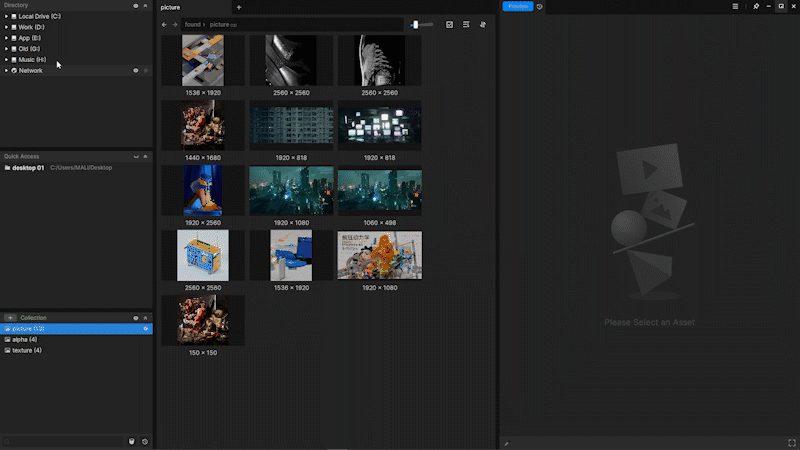
2.2 Quick Access Area
This is where you can save your most frequently used files. You can drag files from the [Tree Directory Area], [Main Browser Area], or [System File Explorer] here for easy access (it's recommended to drag slightly horizontally before dropping into Quick Access, otherwise it might scroll down). You can also click the star icon to the right of files in the [Tree Directory Area] to add them to Quick Access.
The first time you open Found, your system's File Explorer favorites and Quick Access folders will be synced here. Right-click the panel title bar's [Sync Windows Quick Access] to sync again.
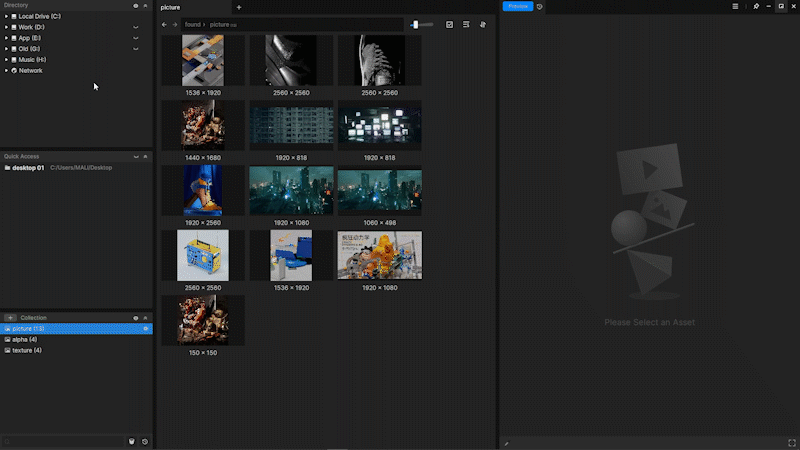
2.2.1 Hide Sidebar
If you don't want to view the sidebar, move your mouse to the panel divider line and click the collapse button to hide it.

2.2.2 Modify Alias
By double-clicking a folder or right-clicking and selecting [Modify Alias], you can change the displayed name of a folder in the [Quick Access Area]. The [Alias] will not modify the original name of the folder; it is only used for display.
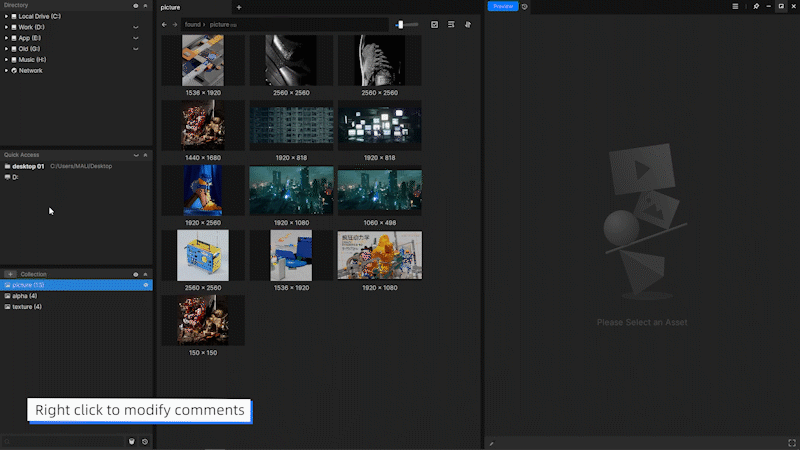
2.2.3 Recently Accessed
In the "Recently Accessed" option, you can find the 100 most recently previewed asset files.

2.3 Collections Area
Collections are Found's unique feature. You can re-categorize existing assets stored in various folders on your computer into different collections based on project requirements or personal preferences. See [Collections Feature] below for details.
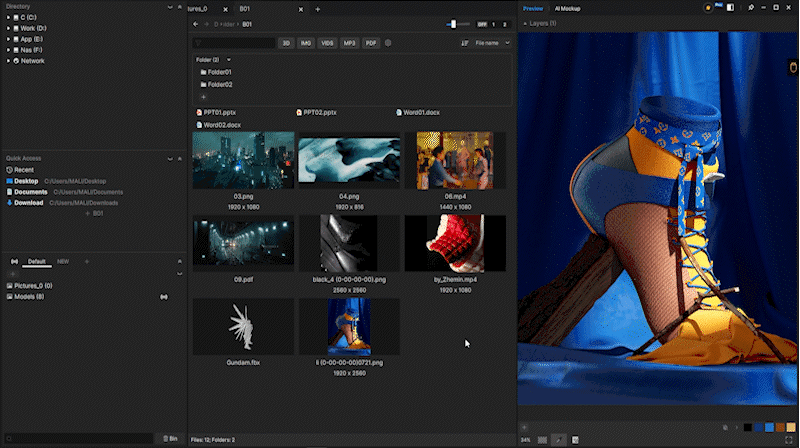
3. Main Browser Area
The [Main Browser Area] is where you quickly browse and select image, video, model, and other file assets. The top [Tab Bar] allows you to open multiple folders for preview simultaneously by clicking the plus icon. The [Address Bar] enables quick navigation to copy the current path and jump up one level.

3.1 File Icons
Assets in Found are divided into three different categories: folders, visual assets (display thumbnails and information), and non-visual resources.
Hold down the middle mouse button (without releasing) on a visual asset to display its detailed information.
For image assets, holding down the middle mouse button and dragging the image from its position will create a [Float Image]. See [Float Image] for details.
When dragging an asset with the left mouse button, a collection menu will pop up, allowing you to add the asset to a collection.
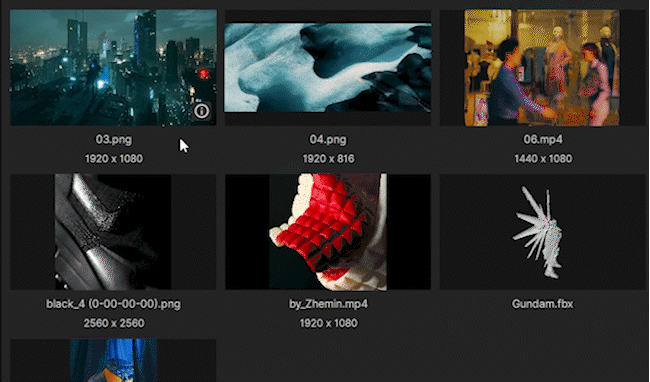
3.2 Quick Search
You can directly type the filename you want to search for in the address bar, and Found will quickly search for the file in the current directory and its subdirectories. You can also use the Tab shortcut key for quick search.

3.3 Filter, Sort, and Other Function Buttons
When a folder contains sequence frame files, you can click icon ① to display the sequence frames as individual images.
Use slider ② to control the size of visual asset thumbnails.
You can use ③ to decide which information to display below the visual asset thumbnails.
You can change the sorting order with ④, or reverse the current order with ⑤ (when the number of files/images is sufficient, a color filtering function will be added).

3.4 File Information Display
When the mouse hovers over a file thumbnail, a file information icon will appear in the bottom right corner. You can click the information icon to get detailed information about the file.

4. Preview Panel
4.1 Full-screen Panel and File Caching
Selected files in the Main Browser Area will be displayed in the Preview Panel. You can maximize the Preview Panel by clicking the "full-screen icon" in the bottom right corner. Alternatively, when your mouse is over the Preview Panel, lightly press the middle mouse button to quickly maximize it.
To facilitate comparison between different files, the Preview Panel automatically caches the two most recently accessed files. If you experience significant lag due to loading extremely large files, or if a file doesn't refresh, you can try quickly accessing three different files to clear the existing preview cache.

Found supports previewing images, videos, 3D models, image sequences, and HDR files. If you have other file types that need previewing, please send your feature request to support@aalab.com.
4.2 Image Color Picker
Click the eyedropper icon to show the color picker bar, click the "plus" to pick a color and temporarily store it in the color picker bar (it will be cleared when Found exits). You can pick colors from anywhere on the screen, not just within the image. Click on a color swatch to copy its color value or delete it.
When picking colors, you can use the Up, Down, Left, and Right arrow keys on the keyboard to precisely control the cursor's position. After entering color picking mode, repeatedly pressing the Enter key allows you to quickly pick multiple colors.
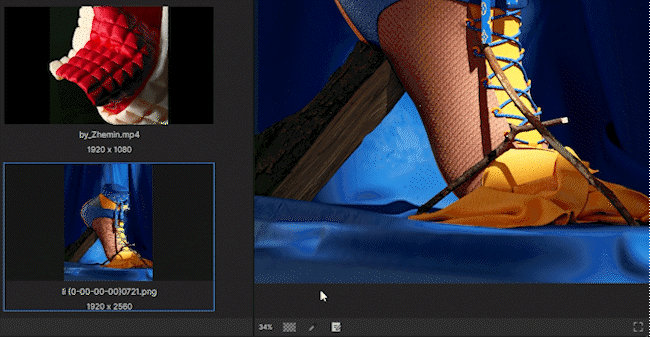
4.3 Asset Notes and Modifying File Thumbnails
You can leave comments for selected assets. Comments are stored in Found's internal database and do not modify the original file. See [Notes Feature] for details.
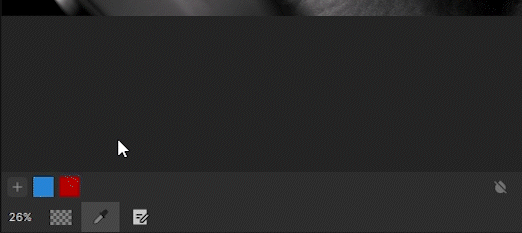
For videos and other file types, you can use the "Set Thumbnail" function to set the currently previewed frame as the file's thumbnail.
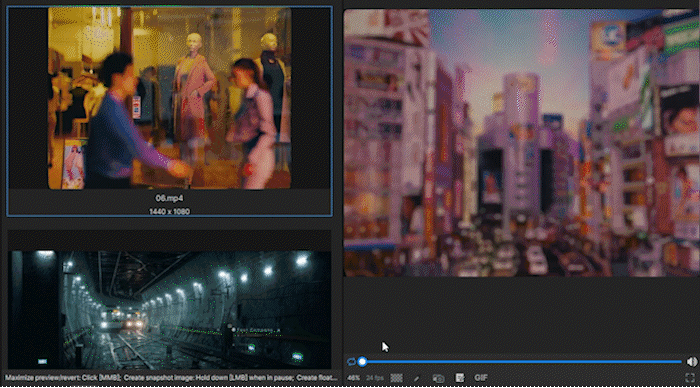
4.4 Quick Screenshot of Preview Content and Float Image
When a video is paused, you can copy the current frame by right-clicking. Alternatively, holding the left mouse button for half a second will generate a thumbnail that can be dragged and saved directly to any location, such as a folder, collection, or third-party application (e.g., WeChat, DingTalk, web pages, etc.). This method also applies to image and sequence frame previews.

When a video is paused, hold down the middle mouse button for half a second to create a float image from the current snapshot.
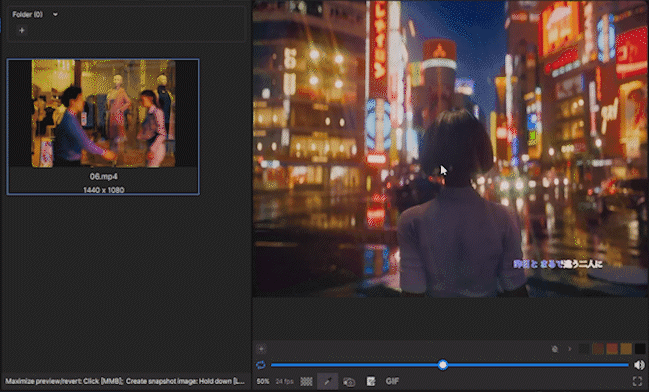
4.5 Image and EXR Preview
4.5.1 Alpha Channel
If the image you are previewing has an alpha channel, you can enable or hide the alpha channel by clicking the checkerboard icon in the toolbar below.
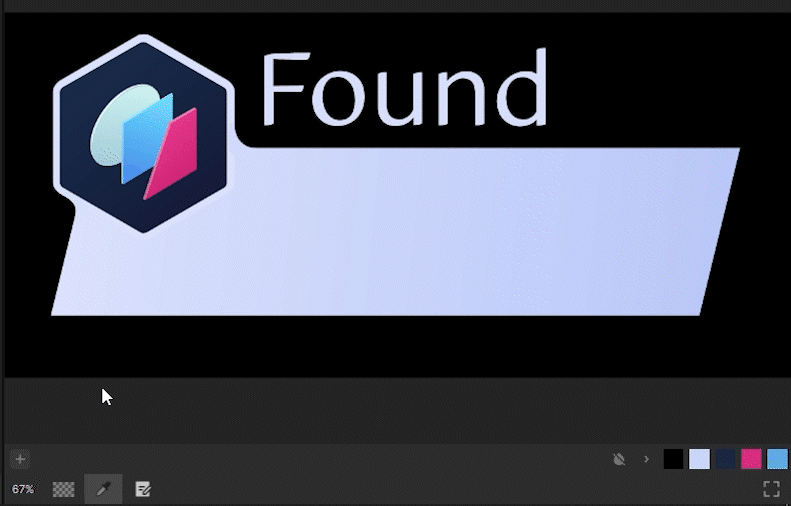
4.5.2 EXR Preview
You can easily preview EXR images. EXR files with multiple layers can also be switched for preview in the layer options in the top left corner. This feature is only available for Pro users.
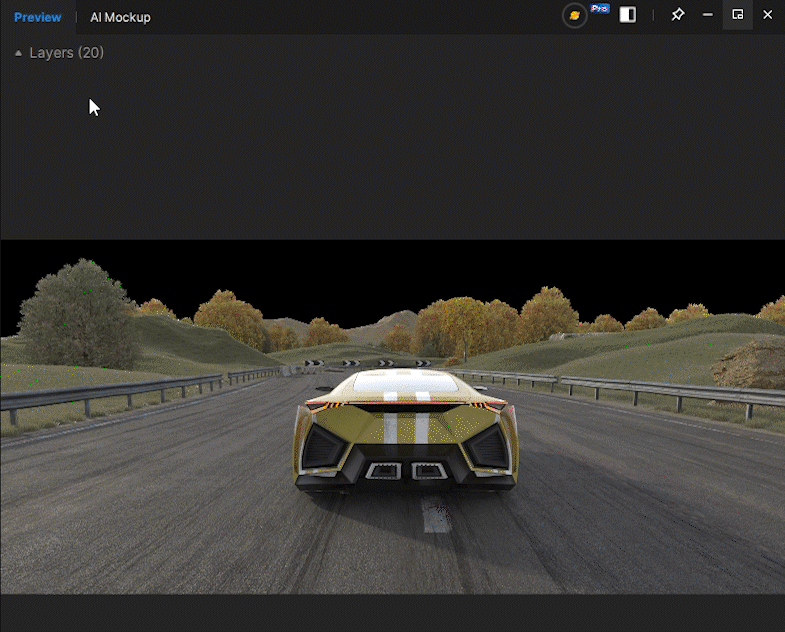
4.5.3 ACEScg Color Space Image Preview
Found also supports previewing your images using the ACEScg color space. When previewing, click the ACES icon to use the corresponding color space. This feature is only available for Pro users.
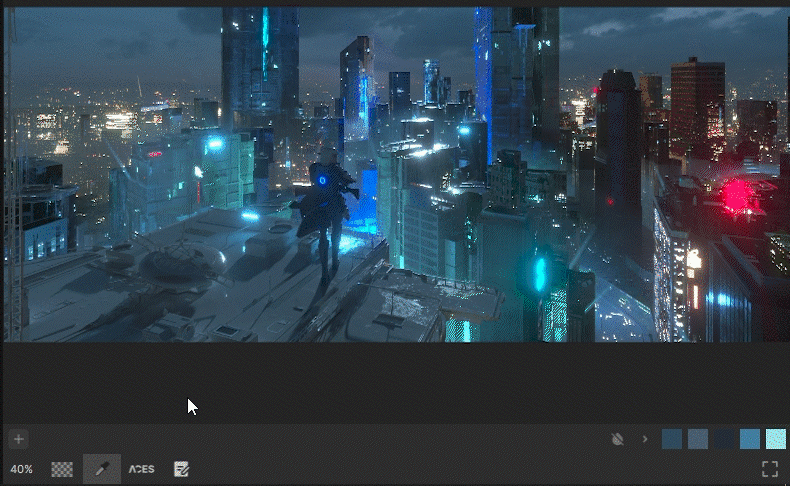
4.6 3D Model Preview
Found supports previewing various 3D model files, such as OBJ, FBX, ABC, etc. When previewing 3D models, you can rotate the view by holding the left mouse button, and pan the view by holding the middle mouse button.
4.6.1 Wireframe and UV Preview
You can enable the grid plane, wireframe mode, and UV display sequentially using the options in the toolbar. The "Default View" function will reset the current viewport view.
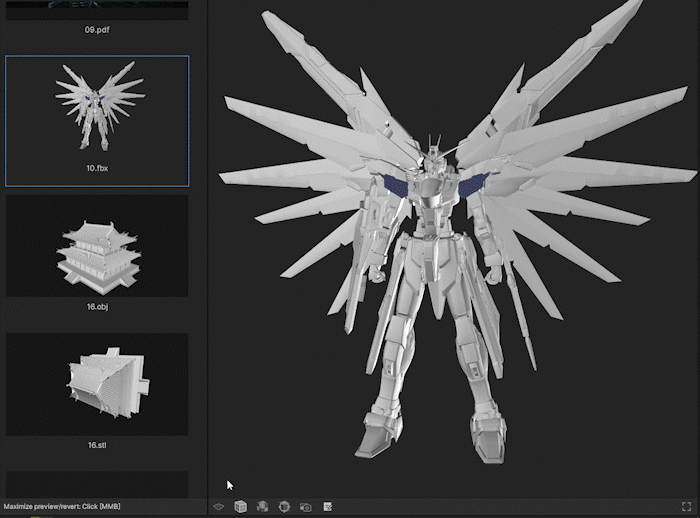
4.6.2 FBX Animation Preview
If your FBX file contains animation, Found will directly read the animation range and play the animation during preview. Currently, it does not support point-level deformation animation preview.
4.7 Sequence Frame Preview
4.7.1 Sequence Frame File Recognition
Found supports identifying and previewing sequence frame formats. By default, it only supports standard-named sequence frame files. File naming must meet the following criteria:
"abc_0000" i.e., "characters + separator + four or more digits", and at least four or more images will be recognized as a sequence. If you need to modify the recognition rules, you need to enable Pro features.
If you need to unrecognize a sequence, you can click the sequence frame recognition button to the right of the address bar, or select "Cancel Sequence Frame Display" from the file's right-click menu.
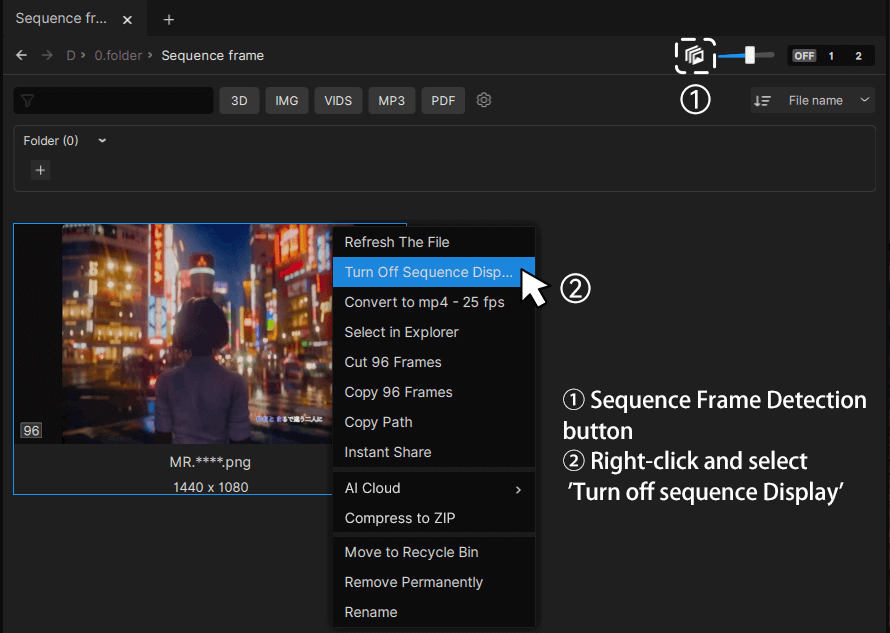
4.7.2 Sequence Frame Rate Modification
You can modify the playback frame rate of a sequence frame while it is in preview mode. Note that playing sequence frames exceeding 60fps may result in dropped frames if your computer's performance is insufficient.

4.7.3 Sequence Frame to Video
You can convert sequence frames to MP4 from the right-click menu. The default conversion frame rate is 30fps. If you need to convert to different frame rates and resolutions, you can enable Pro features.
4.7.4 Sequence Frame Range Display
The number displayed in the bottom left corner of a sequence frame thumbnail, ①, represents the total number of frames in that sequence. You can view the frame range in the detailed file information. ② When the frame number is red, it indicates that there are missing frames within that range. You can check the file details to confirm which specific frames are missing.
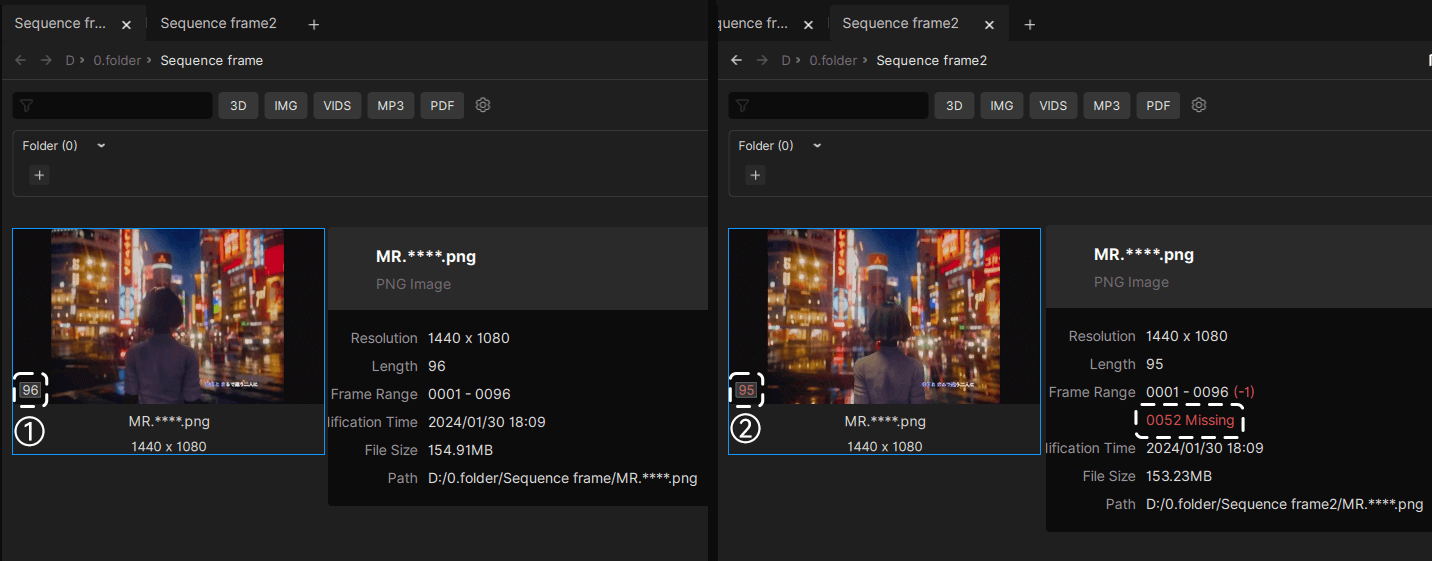
4.8 Preview Panel - Video Preview
Found supports previewing various video formats, including standard MP4, MOV, MXF, AVI, and more. When previewing a video file, you can click the screen with the left mouse button to play/pause at any time. Holding the left mouse button on the screen and dragging allows you to scrub frame by frame to find key positions in the video.
Video timecodes are displayed with frame precision. You can click the loop button on the left to automatically loop the video.
4.8.1 Video to GIF
You can enter GIF mode to cut a specific segment and convert it to a GIF. This feature requires a Pro subscription. Click for more details: https://aalab.com/features/asset-management
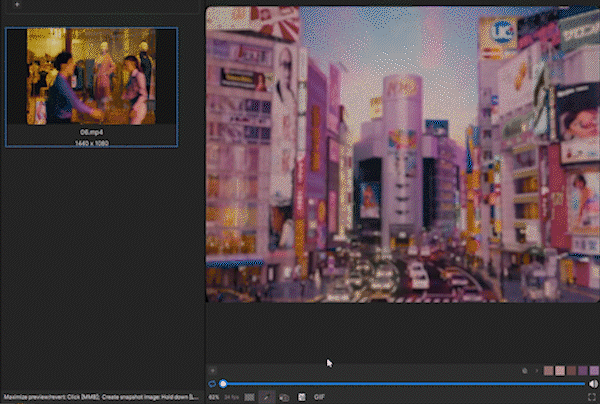
4.9 Preview Panel - HDR Preview
Found supports direct preview of HDR panoramic images, making it easy for you to quickly find the HDR panoramic image you need in your 3D rendering workflow. Most spherical images that are suitable as panoramic images and are in HDR or EXR format will be automatically recognized as panoramic images.
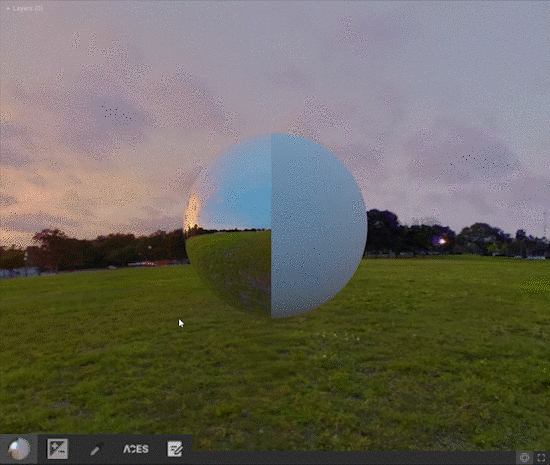
You can click the material ball with the left mouse button to adjust the distribution of specular or diffuse material on the material ball, and rotate with the left mouse button to view the HDR background. In the toolbar, you can show/hide the material ball and adjust exposure. If you need to disable HDR display, you can click the spherical grid button on the right.
4.10 Preview Panel - Audio Preview
If you select an audio file in the Main Browser Area, it will automatically switch to the Audio Preview Panel. All audio files in the currently active tab in the Main Browser Area will be presented as an audio playlist. You can switch between different audio files in the Main Browser Area or Preview Panel and drag the progress bar to listen to the content.
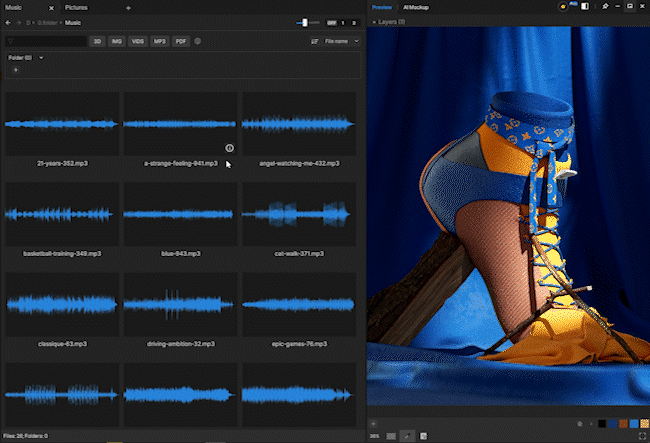
5. Collections Feature
Collections are for reorganizing assets without modifying their original location (if they originate from local storage). You can use collections for any purpose, such as: gathering textures from different folders, collecting reference images for your next project, or any other scenario.
Collections are based on Found's database system. When you place an asset into a collection, Found creates a virtual shortcut in the database pointing to that asset, rather than creating a copy of the file. Collections will reflect any changes made to the original file. Collections are like Pinterest boards, but a local version.
However, there is one exception: when new assets come from non-local storage (e.g., a web browser). For example: adding material to a collection using Found's browser plugin (https://www.aalab.com/plugin). In this case, Found will place these newly generated images into the database folder specified during Found's installation.
5.1 Creating New Collections
You can quickly create new collections using the methods below, or by using the Found browser plugin.
5.1.1 Direct Creation
Click the plus icon to create directly. Double-click or right-click to rename (note that each new collection needs to be renamed before the next one can be created).
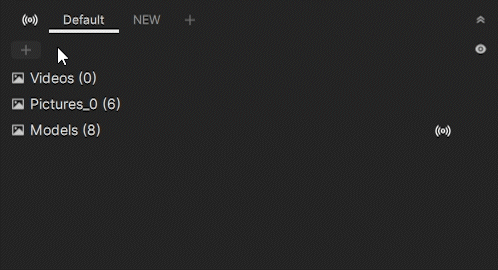
5.1.2 Creating from Existing Folders
Directly drag a folder or file to the plus icon in [Collections] to automatically create a new collection folder.
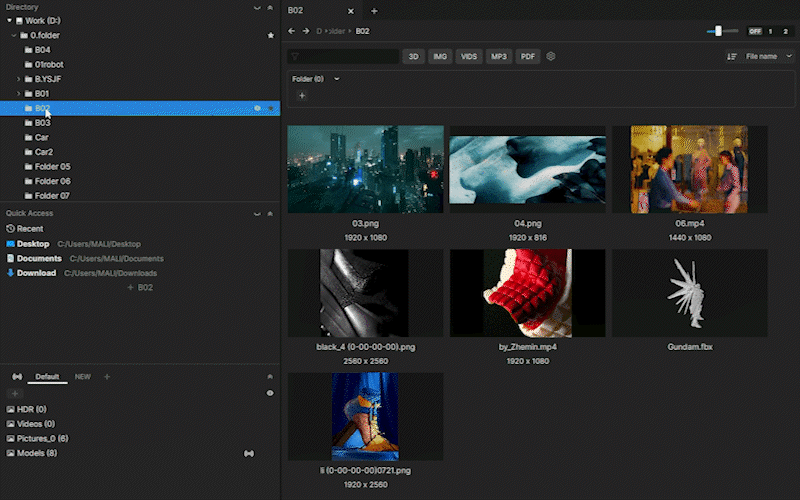
5.2 Adding Assets to Collections
In addition to using the Found browser plugin to grab materials and directly drag folders and files, Found also supports the following ways to add materials to collections.
[Paste Image from Clipboard] In an open collection, press Ctrl + V to create the image from the clipboard as a JPG file and add it directly to the current collection.
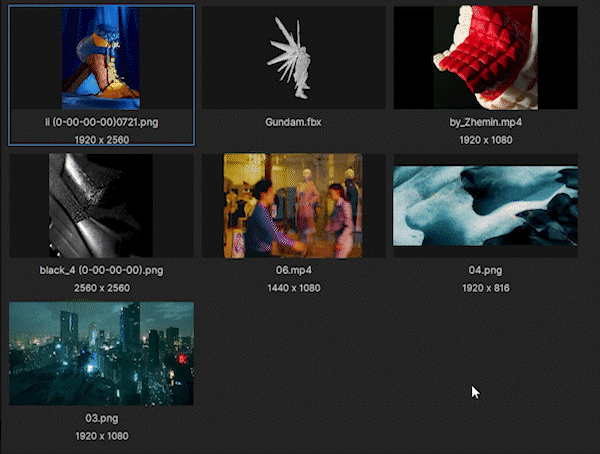
[Add via Context Menu] Select the assets you want to add in the middle panel, hold down the left mouse button to bring up the context menu. The context menu will default to showing the five most recently accessed collections.
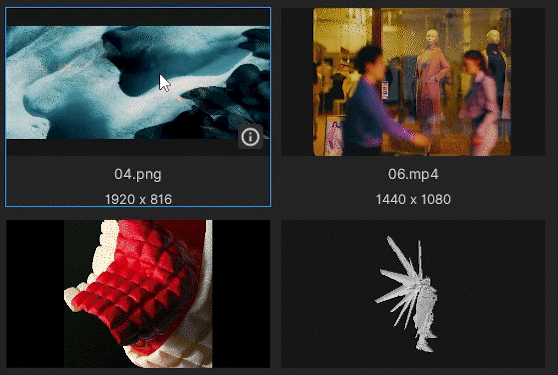
5.3 Collection Categories and Collection Groups
5.3.1 Creating and Deleting Collection Categories
The Collections panel defaults to having "Shared Categories" and "Default Categories." You can add new categories at the "+" icon based on your classification needs. If you need to delete a category, you can do so via the right-click menu on the category tab. Please note that deleting a category will delete all collections within it, and this action cannot be undone.
5.3.2 Collection Groups
Collections within the same category can be grouped. You can select collections you want to group by holding down Shift or Ctrl, then right-click and choose "New Group".
To add new collections to an existing group, hold down the left mouse button on the collection and drag it to the corresponding group option.
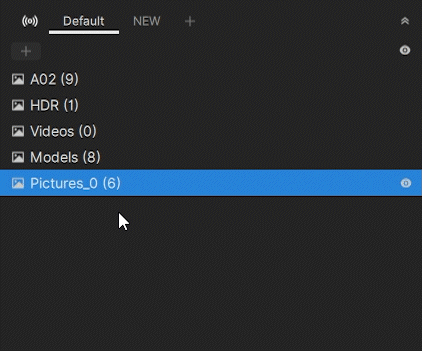
5.4 What happens when assets are deleted from a collection?
If assets are from your local storage, they will only be removed from the collection, and your system's source files will not be deleted.
If they are assets collected from a browser plugin or images pasted from the clipboard, they will be marked as deleted. If other collections contain the same asset, it can still be found in those other collections. When you delete the same asset from all collections, it will be permanently deleted after 30 days (which can be changed in settings) (only if they are not in your local storage).
In either case, you can still find deleted assets in the Recycle Bin before it is cleared.
6. Instant Share
6.1 What is Instant Share?
Instant Share is a unique feature introduced by Found. Without the need for uploading or downloading, you can browse collections shared from your host device using different devices. This facilitates quick asset review in multi-device or team collaboration scenarios. Furthermore, Instant Share uses a client-side streaming method, so you don't have to worry about the security and privacy of your source files, and you can end the sharing at any time.
6.2 How to use Instant Share?
Click the icon below to start sharing.
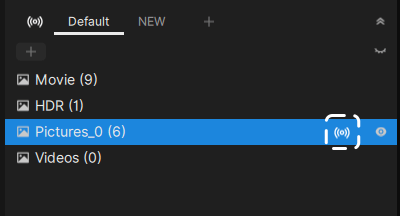
After creating a collection, you can find the ① share button to the right of the collection name. Click ② to enable sharing.
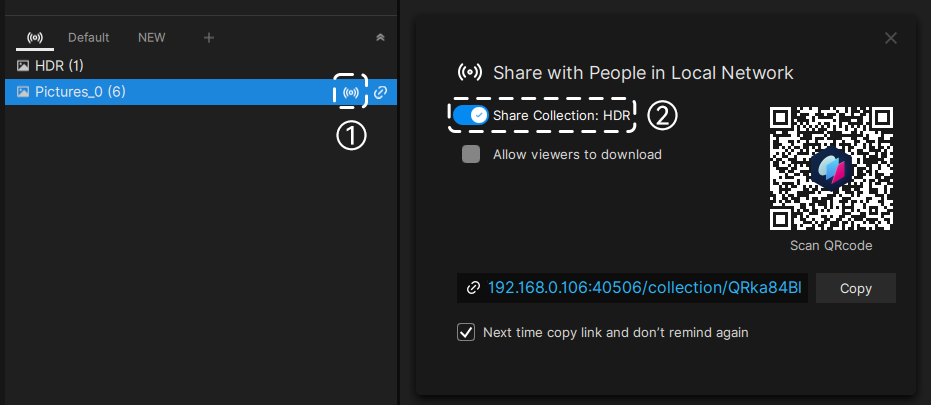
You can scan the QR code on the screen with a mobile device, or access it via a link in your browser. Please note that currently, Instant Share is only available for devices within the same local area network (LAN).
By checking "Allow visitors to download", visiting users will be able to download the source files in that collection. If unchecked, users can only browse the content in the web page.
By checking "Next time, directly copy the link and no longer prompt", clicking the share button next time will directly copy the link, and the sharing window will not pop up again. If you wish to reopen it, go to the "Sharing Collections" tab in the collection panel, click the share button again, and uncheck the option to re-enable the pop-up prompt.
6.3 What files can be shared via Instant Share?
All file formats that can be added to collections can be shared, including regular videos and images, as well as complex 3D models or sequence frames.
6.4 Will Instant Share consume resources on the host sharing device?
Yes, it will. The team has optimized this feature for performance, and typically, sharing most images and videos will not affect the host device's normal operation. Instant Share parses files on the host device and pushes the parsed content in real-time to the accessing devices. Currently, it supports up to five different devices connected simultaneously. If you share files such as large and complex 3D models or sequence frames, you might need to ensure your host device's performance is sufficient.
6.5 Will Instant Share consume data traffic?
Instant Share currently only supports sharing between devices within the same local area network (LAN), so it will not consume extra data traffic during sharing. However, the host sharing device must remain online during sharing.
6.6 How many devices can simultaneously view content during Instant Share?
Currently, up to five different devices can simultaneously view a collection shared from a single host device. Theoretically, given sufficient network speed and hardware (host hardware configuration), a higher number could be supported, but considering the usage patterns of most users, it is currently limited to five devices. If you require more sharing options, please contact us for a customized enterprise version.
7. Notes Feature
Click [Notes] below the [Preview Panel] to add notes to assets. In addition to regular text notes, you can also use [special command characters] to change the file's display name, mark video time points, add custom tags to assets, and more.
7.1 Changing the Display Filename
Enter *Custom Text to change the displayed filename; this will not modify the original filename.
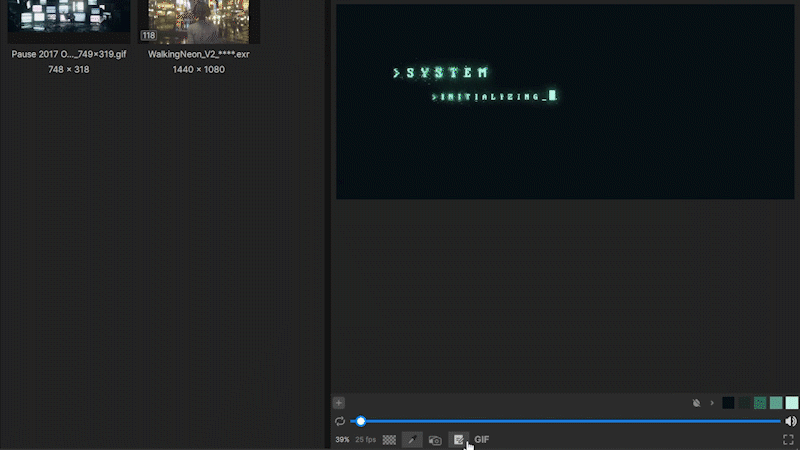
7.2 Marking Video Time Points
Enter :: (two colons) to mark the current time point. Click the time point to jump to the corresponding position.
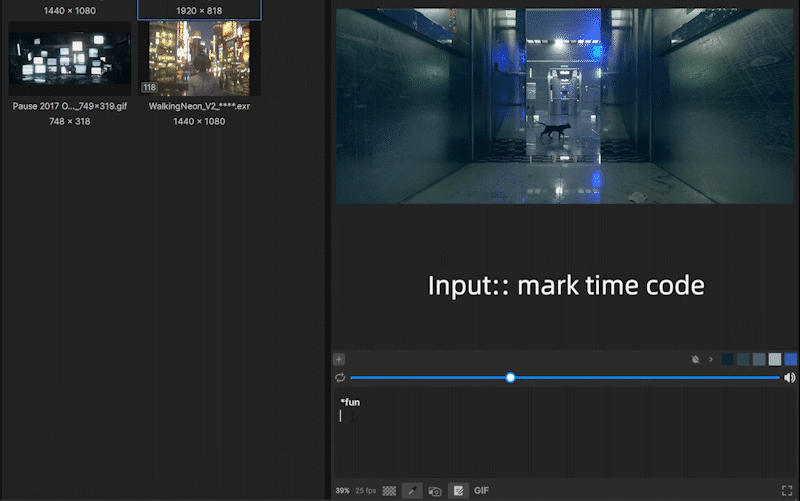
7.3 Adding Custom Tags to Assets
Enter # to add custom tags to assets. Clicking a tag will quickly search for similar tagged files, allowing you to browse them swiftly.
8. Common Shortcut Features
8.1 Float Image
Press the middle mouse button and drag an image asset's thumbnail away from its position to create a float image. Right-click the [Float Image] to close or copy it. When the mouse hovers over the float image, options for rotation, symmetry, black and white, etc., will appear.
Double-click the float image to restore it to 100% scale display, and rotation, mirroring, and other modification options will revert to the image's initial state.
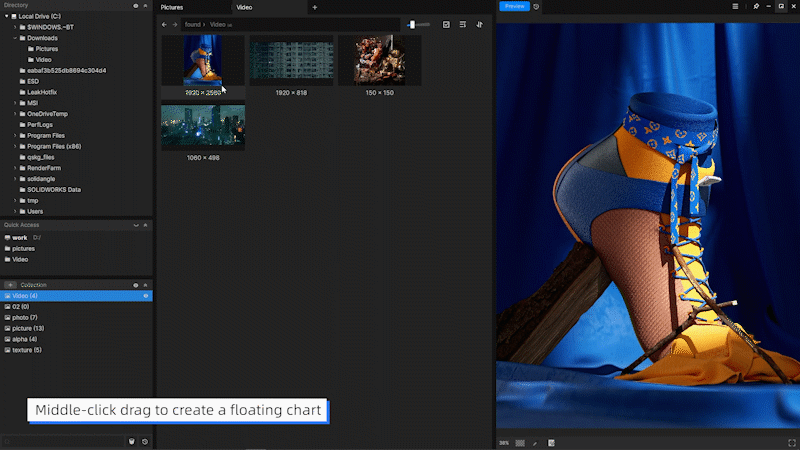
8.2 Video to GIF
[Select Conversion Range] Select a video file, click the GIF button below the [Preview Panel] to switch to GIF mode, and move the slider to crop the generation range.
[Adjustable Parameters] Use the parameters below GIF mode to adjust the FPS frame rate and color depth. Use the mouse wheel to quickly scale and adjust resolution, or directly click the resolution input to enter a value. The maximum resolution is 1000px, and the minimum resolution is one-quarter of the original size.
[Preview GIF] When the GIF has loaded, hold down the left mouse button on the screen or timeline to view a comparison of the current converted GIF still frame and the original frame clarity. Single-click the screen with the left mouse button to play the GIF preview.
[Generate GIF] Wait for loading to complete, and a GIF! icon will appear on the right. Click it to generate the GIF animation.
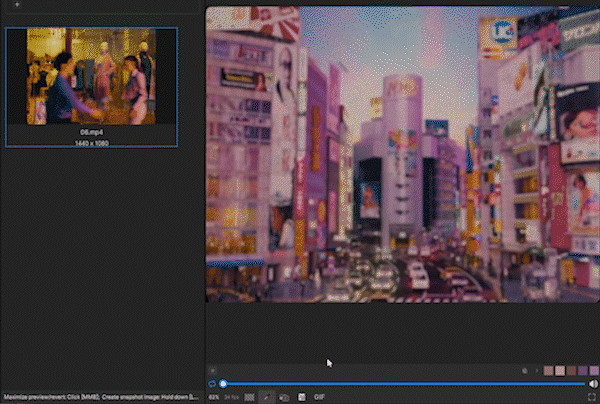
8.3 Compress Image Resolution
You can select high-resolution images, right-click, and choose [Reduce Resolution]. You can reduce the image to 1K, 2K, 4K, or other resolutions.
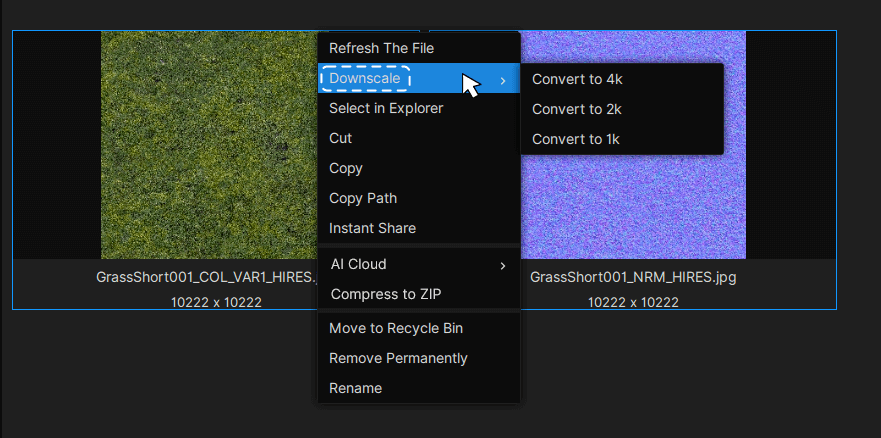
8.4 Video Format Conversion
Select the video you want to convert, right-click, and choose [Convert]. You can convert the video to [GIF animation] or [PNG sequence frames].
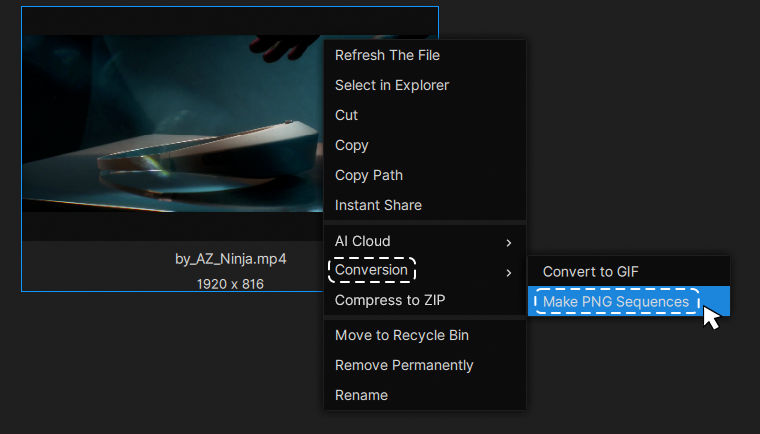
9. Format Whitelist
The format whitelist helps you filter out files you don't want to see. By default, the whitelist feature is enabled. You can disable it using the filter option next to the address bar.
You can access [Settings] - [Format Whitelist] via the menu option in the top right corner. You can add files to Found's whitelist mode for preview by adding *format name, e.g., *avi *rmvb.
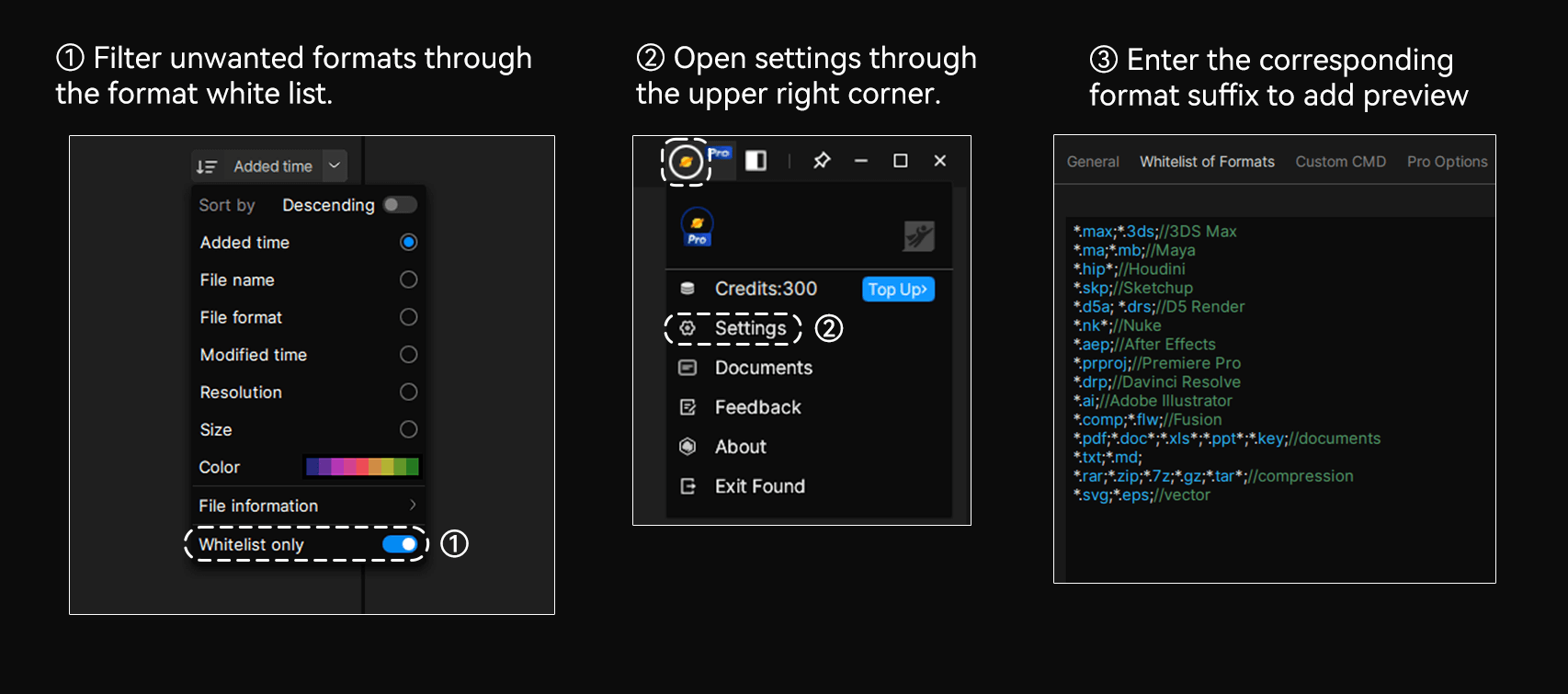
10. Keyboard Shortcuts Overview
[Middle Mouse Button]
In the Main Browser Area, hold down the middle mouse button on a target file to view its detailed information.
In the Main Browser Area, quickly press and drag the middle mouse button on a target file to create a float image of that file.
In the Preview Area, long-press the middle mouse button on a video or sequence frame file to create a float image of the current video frame.
In the Preview Area, short-press the middle mouse button on a video or sequence frame file to maximize the preview area to full screen.
[Esc] With a float image selected, press Esc to quickly close the float image.
[Enter] Quickly pick colors from an image.
[Up, Down, Left, Right Arrows] Select an asset in the Main Browser Area, then use the arrow keys to switch between different assets.
[Video Scrubbing] In the Preview Area, hold the left mouse button on the screen and move the pointer to control video scrubbing frame by frame. [Left/Right Arrow Keys] When playing a video or sequence frame, you can advance or rewind frame by frame. Hold down the left/right arrow key for continuous movement.
11. Browser Plugin
You can click the link to download and install the browser plugin: https://www.aalab.com/plugin
You can drag any image from a webpage to invoke Found's pop-up menu.
Drag an image with the left mouse button to the [Create Float Image] option at the top to create a float image.
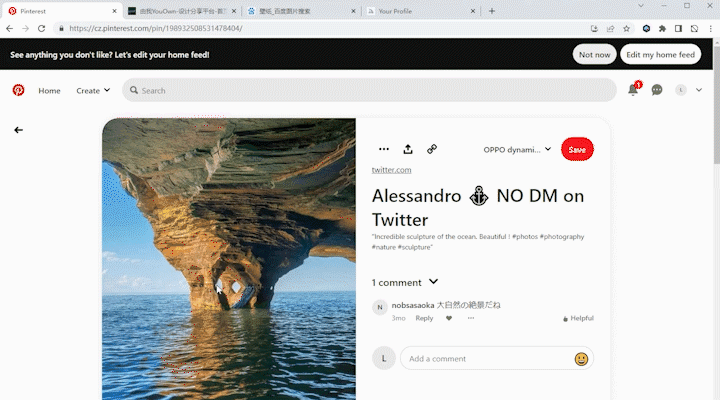
Drag an image with the left mouse button to the [Collections] option below to save the image to a collection (the most recently used collections will be displayed by default below).

12. Pro Official Version
12.1 Pro Features
12.1.1 How to Set Pro Features
Click ① to open the settings panel, click ② Settings, click ③ Pro Options, and set the corresponding functions.
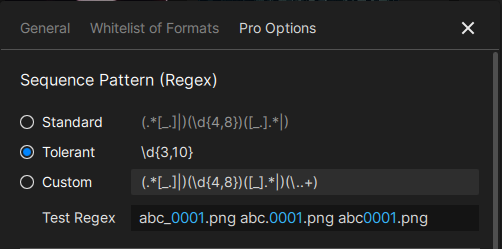
12.1.2 Supports one-click conversion of 4K and higher resolution sequence frames to video.
Video conversion has no frame rate limits, and also supports setting the converted video file resolution to half or one-quarter of the original sequence frame resolution.
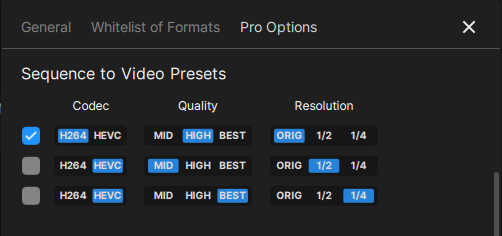
12.1.3 Custom Folder Expansion Levels
Supports custom folder expansion levels up to 9 levels, allowing you to adjust the number of expanded folder layers as needed. Found will also remember the expanded state in different folders. (Changes require opening a new tab to take effect).
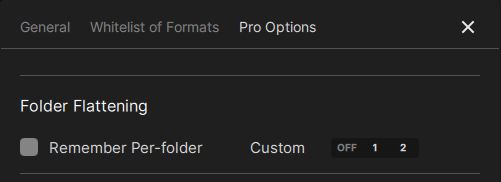
12.1.4 Custom Sequence Frame Recognition Rules
In the Pro version settings, you can choose suitable sequence frame recognition rules based on your usage habits. "Loose" directly supports C4D's default output sequence frame naming convention, avoiding misidentification or missed sequence frames. Professional users can even customize regular expressions to identify complex specifications, meeting your pipeline requirements.
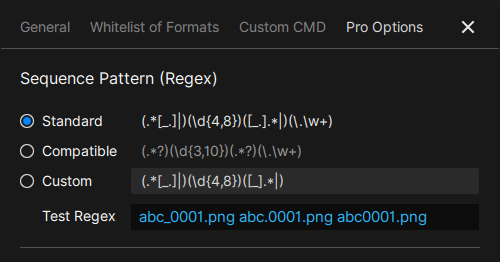
12.1.5 Batch Modify Texture Sizes
You can select multiple high-resolution textures by boxing them and batch reduce them to 4K or 2K resolution with one click. You can also set other options in the options panel, eliminating the need to re-specify texture paths in the renderer's material editor.
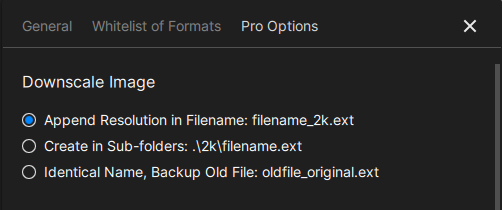
12.1.6 Preview Alpha Background Color
For materials with an Alpha channel, you can freely change the Alpha background color in the Pro settings to meet the needs of browsing transparent background materials.
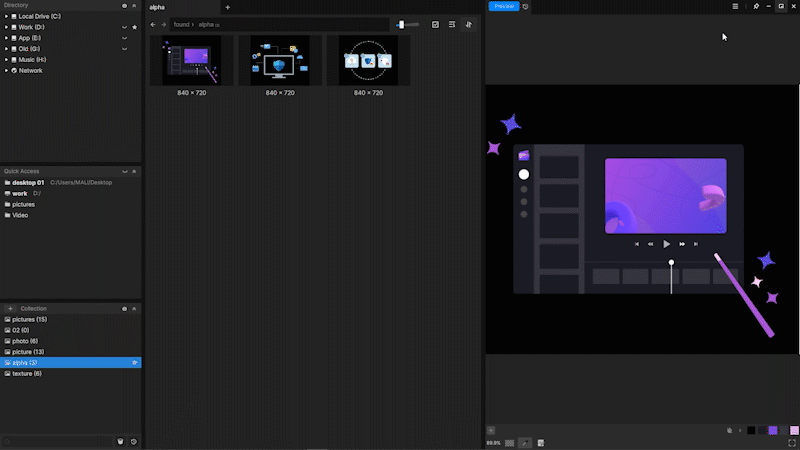
12.2 Supports ACEScg Asset Preview
Supports previewing EXR sequence frames and MP4 files in ACEScg color space. Click the ACES button below the [Preview Panel] to preview.
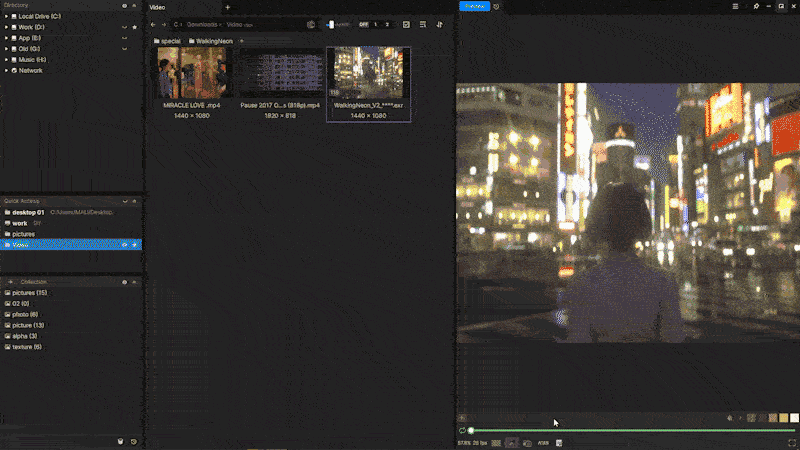
13. Custom Commands and AI Services
13.1 What are Custom Commands?
Custom Commands is a new module introduced in Found v1.1, currently only available to Pro members. This module supports extending Found's functionality by running various extension scripts and programs.
The term "Custom Commands" is merely descriptive of the nature of this feature. Although it also supports directly executing third-party programs without a script interpreter, most of the time, this functionality is achieved in the form of one or more scripts. Therefore, in the following text, the terms "Custom Commands" and "scripts" can often be used interchangeably.
As of the latest version (v1.1), Custom Commands support calling extension scripts from the right-click menu in the main browser area and the preview panel.
13.2 How to View and Enable Custom Commands?
In the Custom Commands tab within the settings panel, you can view local and online community scripts (we will update online community scripts periodically, so remember to check back occasionally to avoid missing new features). Online community scripts need to be downloaded locally before they can be enabled.
In the local script panel, you can activate or deactivate a custom command using the checkbox on the left. You can drag the control button on the far right to adjust a command's display order in the menu.
13.3 How are Custom Commands executed?
Typically, custom commands are saved as one or more scripts in the "Documents/Found/scripts" directory. You can modify the value of "custom_commands_path" in the found.ini configuration file to point to different directories, or even multiple paths (such as NAS addresses, to enable multi-terminal reuse of a dynamically updated shared script folder); different addresses should be separated by a semicolon. Each custom command will have its own folder within the scripts directory, containing a manifest.json file that records the key parameters of the custom command.
When Found runs, it scans the directory pointed to by "custom_commands_path", identifies all manifest.json files in subfolders, and parses them as custom commands.
Additionally, the "Documents/Found/enabled_scripts.json" file records all enabled scripts. When a custom command is executed, it first parses the variables contained in the "param" parameter, then appends the "param" parameter as command-line arguments to the interpreter and runs the interpreter. Therefore, you can use any type of interpreter (e.g., Python or Powershell, etc.), various third-party programs that support command-line arguments, or even your own programs, to execute any command. We recommend using Python as a bridging language for calling various third-party commands and services.
13.4 How to Modify/Write Custom Commands?
A custom command requires its own folder, which must be located within the directory specified by "custom_commands_path" in found.ini, and contain a manifest.json file.
- manifest.json file parameters are as follows:
- Name: The name of the current custom command. If the name contains a semi-colon ":", the characters before the colon will be displayed as a parent grouping menu in the menu, and the characters after the colon will be displayed as a submenu item. If multiple custom commands have the same parent grouping name, they will be categorized into the same parent menu as parallel sub-items. For example, if there are two custom commands named "AI: example1" and "AI: example2", when these two custom commands are enabled, they will both be categorized under the "AI" parent menu as parallel sub-items "example1" and "example2".
- Entry: The entry point of the script within Found. In Found v1.1, there are two entry points: "browser_context" for the browser area right-click menu, and "preview_context" for the preview panel right-click menu.
- Desc: A description of the custom command, usually including detailed usage and related information.
- Filters: Supported format filters, separated by a semi-colon ";". Specifically, the filter "." means the command supports execution on folders. Tip: If the filter includes a path, the command can only be executed in that specific path.
- Author: The author's name for the command.
- Version: Version number.
- CMD: The executable program or script interpreter.
- Param: Command-line arguments appended after the interpreter when executing this command. This usually includes the main entry script file and relevant special variables and parameters, but can also be other arguments.
Specifically, Param supports the following special variables:
$FILES: All selected files in the browser area, separated by a vertical bar "|" symbol if there are multiple files.$FOLDER: If invoked by right-clicking on a blank area in the browser, it is the current browser area path; if right-clicking on a folder in the browser, it is the path of that folder.$ENTRY: The entry point of the script.$COLLECTION: If browsing a collection, this variable represents the UUID of the current collection.$ASSET_ID: The ID(s) of one or more assets, separated by a vertical bar "|" symbol if there are multiple assets.
If you need to add a new custom command to rename selected MP4 files in the browser area to M4V, and this command uses a Python script to execute, then you need to:
- Create a new folder in the "Documents/Found/scripts" directory.
- Create a "manifest.json" file in that folder with the following content:
{ "Name": "Rename: MP4 to M4V", "Entry": "browser_context", "Desc": "Renames selected MP4 files to M4V.", "Filters": "mp4", "Author": "Your Name", "Version": "1.0", "CMD": "python", "Param": "to_m4v.py --files \"$FILES\"" } - Create a "to_m4v.py" file in that folder, and implement the renaming function by reading the
--filesparameter in Python.
13.5 Found API
Found provides a series of RESTful APIs, allowing users to customize various Found functions to some extent. Additionally, if a script involves modifying asset files, such as renaming, we strongly recommend doing so through the API to maintain database integrity and avoid the risk of losing various data in Found. [View API Documentation] We will continue to open more APIs in future versions, so stay tuned.
13.6 AI Generation Function
The local AI generation function (based on Stable Diffusion) is being optimized and will be provided as a custom command later. Please stay tuned for updates in the online script community.
We have implemented local AI generation (based on Stable Diffusion) and AI cloud service generation (based on a series of proprietary high-quality models, also open for custom needs for enterprise clients) through custom command features and Found API.
Local AI generation: Using local AI script presets for generation does not incur additional fees, but you need to complete the local deployment of Stable Diffusion. For relevant steps, please refer to our series of video tutorials that will be released later. The generation speed and success rate of local AI generation are related to your computer's configuration. Due to the special nature of this function, we cannot guarantee that all users' computers can successfully complete the corresponding deployment, nor will we provide local deployment-related consultation services for each user.
AI cloud service: Using AI cloud service-related functions will consume corresponding cloud service points. Currently, during the testing period, we provide all Pro users with a certain number of free service points each month. After the points are used up, additional points need to be purchased to continue use. Click here for more details.
14. Local AI Installation Guide
Found AI supports running on a locally deployed Stable Diffusion. You can either use the features provided by Found officially or write your own functions by calling the API and then apply them in Found.
First, ensure Stable Diffusion is deployed locally. To view, you also need to install the ControlNet plugin:
A1111 https://github.com/AUTOMATIC1111/stable-diffusion-webui
ControlNet Plugin https://github.com/Mikubill/sd-webui-controlnet
ControlNet Models https://huggingface.co/lllyasviel/ControlNet-v1-1/tree/main
File storage paths are as follows:
ControlNet Plugin: /extensions/ControlNet
ControlNet Models: /extensions/sd-webui-controlnet/models
ControlNet Preprocessors: /extensions/sd-webui-controlnet/annotator/downloads
After deploying and starting Stable Diffusion, confirm that it is running normally. Next, download the suitable local AI script from the Found community. In Found, select the relevant asset file, and right-click to execute the local AI script.
When executing for the first time, the program will guide you to select the Stable Diffusion directory after installing dependencies. Please ensure that the webui version is higher than a9fed7c3 (Week 11, 2023) and that the ControlNet plugin is installed.
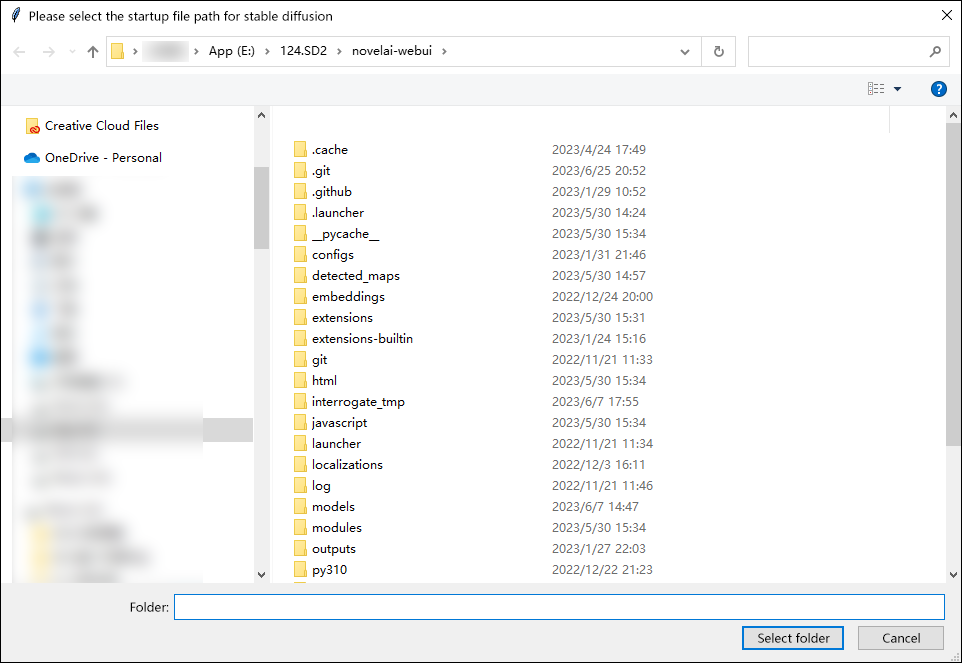
After completing the environment dependency installation, you will see a default settings pop-up, with the following functions:
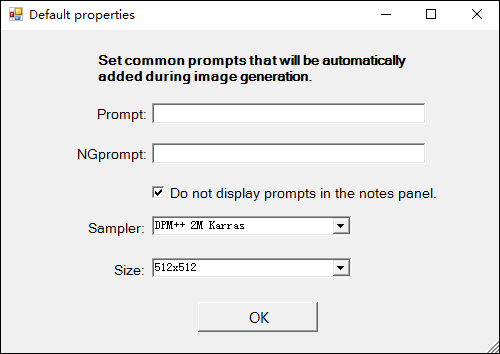
-
Common Prompts: For example, prompts like "masterpiece" and "high quality" are frequently used. Simply add them in the settings, and they will be automatically appended each time you use Found AI, eliminating manual input.
-
Hide Settings Words in Notes: Enabling this function will prevent commonly used prompts from appearing in the generated result's prompt history, making the record more concise.
-
Default Generation Size: Set the maximum resolution for each image generation based on your actual VRAM.
-
Default Sampler: This option allows you to change the default sampling method for generated images.
Click "OK" to start using Found AI to generate image results in your local Stable Diffusion.
14.1 Custom Settings
If you wish to make custom settings, you can follow these steps:
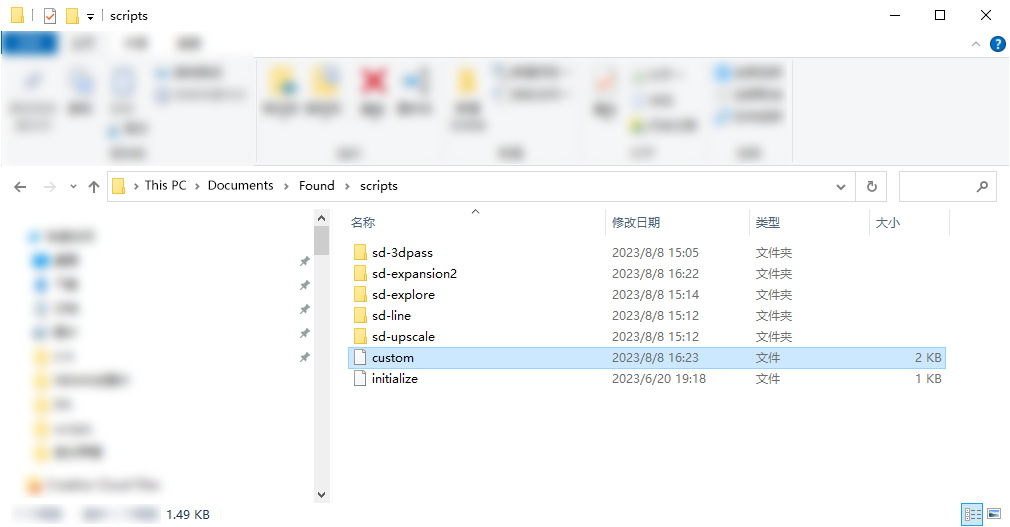
-
On your computer system, navigate to the "Documents/Found/scripts" folder.
-
In this folder, locate the file named "custom".
-
Right-click on the file and choose to open it with Notepad.
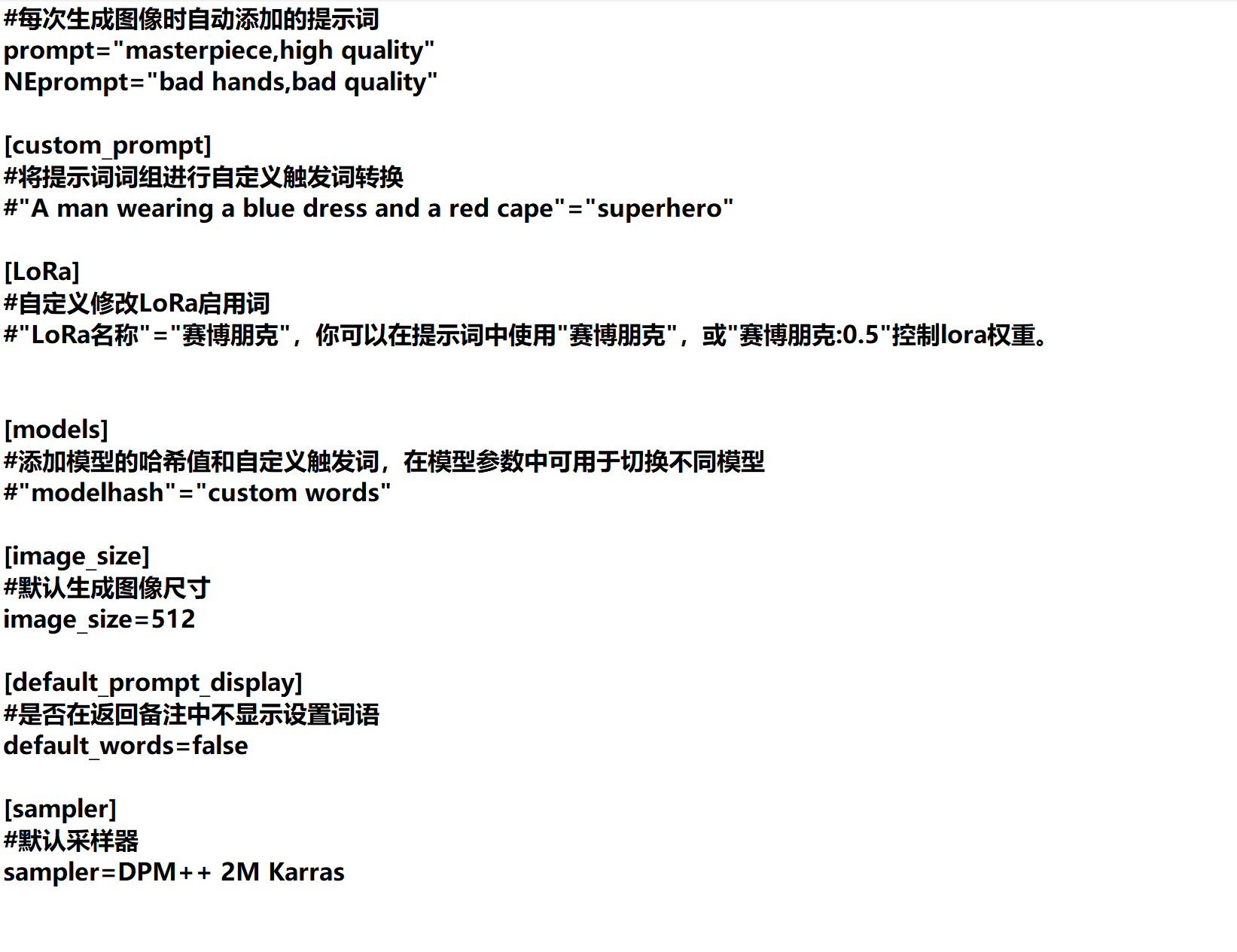
Next, you can add the following custom settings to the file:
-
[default prompt]: These are your set common prompts.
-
[custom prompt]: With this setting, you can use a short word or phrase to trigger a longer sentence or description. For example, by entering:
"A man wearing a blue dress and a red cape"="superhero"This means that when you input "superhero", it will automatically be converted to "A man wearing a blue dress and a red cape".
-
[lora]: In this section, you can set common LoRA phrases as custom trigger words. For example, if you have a cyberpunk-style LoRA named "cyberpunk", you can set it like this:
"cyberpunk"="cyberpunk"This means that when you enter "cyberpunk", it is equivalent to using that LoRA setting. You can also adjust the LoRA's weight by entering "cyberpunk:0.5".
[model]
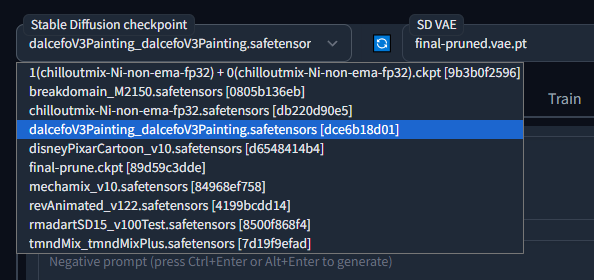
[model]
By default, Found will use the model currently loaded in Stable Diffusion. However, to avoid having to remember the model's hash value each time you switch, you can set an easier-to-understand term for frequently used models here. For example, setting the model hash value "f2bsued5" to "Realistic":
"f2bsued5"="Realistic"
This way, when using the Found AI feature, you only need to enter "model:Realistic" in the parameters, and the system will automatically load the model associated with this hash value.
[image_size] Sets the default image generation size. Available values are 512, 768, and 1024.
[default prompt display] Sets whether to display common prompts in the returned parameters. Select "true" to display, "false" to hide.
[sampler] Default sampler selection. This option usually does not need to be changed.
14.2 Common Issues with Local AI Link
Q: What should I do if my Stable Diffusion version updates or I change the path?
A: Simply re-execute any function of the local version, and the system will restart the pre-configuration process.
Q: Why did I receive an "Execution failed" message?
A: Most "execution failed" reasons are related to missing necessary plugins or ControlNet models. Please ensure that the required models and plugins for the script are installed in your Stable Diffusion.
Q: Why does the script get stuck at "installing pip environment dependencies" during its first run?
A: This indicates that the script is downloading the necessary dependencies for execution. This issue typically arises due to network problems preventing or slowing down the download. First, check your network firewall settings. If the problem persists, try switching to a different network environment.
15. Found API Documentation
/found/get_version
Basic Information
Path: /found/get_version
Method: GET
Interface Description:
Gets the Found version number.
Request Parameters
Headers
| Parameter Name | Parameter Value | Required | Example | Notes |
|---|---|---|---|---|
Content-Type | application/json | Yes | - |
Body
(None)
Return Data
| Name | Type | Required | Default Value | Notes | Other Info |
|---|---|---|---|---|---|
string | No |
/found/log
Basic Information
Path: /found/log
Method: POST
Interface Description:
Outputs messages to the log.
Request Parameters
Headers
| Parameter Name | Parameter Value | Required | Example | Notes |
|---|---|---|---|---|
Content-Type | application/json | Yes | - |
Body
| Name | Type | Required | Default Value | Notes | Other Info |
|---|---|---|---|---|---|
message | string | Yes |
Return Data
| Name | Type | Required | Default Value | Notes | Other Info |
|---|---|---|---|---|---|
string | No |
/found/get_database_path
Basic Information
Path: /found/get_database_path
Method: GET
Interface Description:
Gets the local Found database directory path, e.g., "C:/ProgramData/Aalab/Found/database.found".
Request Parameters
Headers
| Parameter Name | Parameter Value | Required | Example | Notes |
|---|---|---|---|---|
Content-Type | application/json | Yes | - |
Body
(None)
Return Data
| Name | Type | Required | Default Value | Notes | Other Info |
|---|---|---|---|---|---|
string | No |
/found/alert
Basic Information
Path: /found/alert
Method: POST
Interface Description:
Creates a Found internal alert message.
Request Parameters
Headers
| Parameter Name | Parameter Value | Required | Example | Notes |
|---|---|---|---|---|
Content-Type | application/json | Yes | - |
Body
| Name | Type | Required | Default Value | Notes | Other Info |
|---|---|---|---|---|---|
type | string | Yes | ok | error | ||
message | string | Yes |
Return Data
| Name | Type | Required | Default Value | Notes | Other Info |
|---|---|---|---|---|---|
success | boolean | Yes | |||
message | string | Yes | Invalid Type |
/asset/get_uuid
Basic Information
Path: /asset/get_uuid
Method: POST
Interface Description:
Gets the UUID of a single asset in the database. Does not initialize files not yet recorded in the database.
Request Parameters
Headers
| Parameter Name | Parameter Value | Required | Example | Notes |
|---|---|---|---|---|
Content-Type | application/json | Yes | - |
Body
| Name | Type | Required | Default Value | Notes | Other Info |
|---|---|---|---|---|---|
file | string | Yes | Supports UUID or path |
Return Data
| Name | Type | Required | Default Value | Notes | Other Info |
|---|---|---|---|---|---|
success | boolean | No | |||
message | string | No | |||
data | object | No | |||
├─ id | string | No |
/asset/get_thumbnail
Basic Information
Path: /asset/get_thumbnail
Method: POST
Interface Description:
Gets the thumbnail address of a single asset. Returns empty if the file is invalid or no thumbnail exists.
Request Parameters
Headers
| Parameter Name | Parameter Value | Required | Example | Notes |
|---|---|---|---|---|
Content-Type | application/json | Yes | - |
Body
| Name | Type | Required | Default Value | Notes | Other Info |
|---|---|---|---|---|---|
file | string | Yes | Supports UUID or path |
Return Data
| Name | Type | Required | Default Value | Notes | Other Info |
|---|---|---|---|---|---|
string | No |
/asset/set_thumbnail
Basic Information
Path: /asset/set_thumbnail
Method: POST
Interface Description:
Fails if the asset does not exist in the database.
When the thumbnail length is less than 1000 characters, it checks if the characters form a valid local image file. If so, it reads the thumbnail as a file. Otherwise, it attempts to parse it as a base64 encoded image file for the thumbnail.
When the thumbnail is base64, the mode parameter is ignored, and the new thumbnail is not written to the database.
Request Parameters
Headers
| Parameter Name | Parameter Value | Required | Example | Notes |
|---|---|---|---|---|
Content-Type | application/json | Yes | - |
Body
| Name | Type | Required | Default Value | Notes | Other Info |
|---|---|---|---|---|---|
file | string | Yes | Supports UUID or path | ||
thumbnail | string | Yes | |||
mode | string | No | ref | copy | ||
| Determines whether the thumbnail rewrites a database reference or copies a new one to the thumbnails directory using a UUID filename. If an original thumbnail already exists in the cache, it will be deleted (if different from the new thumbnail address). If a thumbnail exists but is not in the cache, the original thumbnail file will not be changed. |
Return Data
| Name | Type | Required | Default Value | Notes | Other Info |
|---|---|---|---|---|---|
success | boolean | Yes | Fails if no thumbnail | ||
message | string | Yes | Thumbnail is not available | ||
data | object | Yes | |||
├─ thumbnail_path | string | Yes |
/asset/rename
Basic Information
Path: /asset/rename
Method: POST
Interface Description:
Renames a file (automatically corrects all associated database asset information, such as notes and collections). If no record of the asset exists in the database, it is equivalent to merely renaming the file.
Request Parameters
Headers
| Parameter Name | Parameter Value | Required | Example | Notes |
|---|---|---|---|---|
Content-Type | application/json | Yes | - |
Body
| Name | Type | Required | Default Value | Notes |
| new_filename| string | Yes | | New filename. If it's a sequence frame and lacks serial numbers, _(original serial number) is automatically appended before the extension (if existing). Otherwise, the number of digits must be at least the original number of digits. | |
Return Data
| Name | Type | Required | Default Value | Notes | Other Info |
|---|---|---|---|---|---|
success | boolean | Yes | |||
message | string | Yes | |||
data | object | No |
/asset/get_asset_info
Basic Information
Path: /asset/get_asset_info
Method: POST
Interface Description:
Gets asset information as JSON after it has been analyzed.
Request Parameters
Headers
| Parameter Name | Parameter Value | Required | Example | Notes |
|---|---|---|---|---|
Content-Type | application/json | Yes | - |
Body
| Name | Type | Required | Default Value | Notes | Other Info |
|---|---|---|---|---|---|
file | string | Yes | Supports path and UUID; sequence frames recognize **** or #### (strict digit validation) |
Return Data
| Name | Type | Required | Default Value | Notes | Other Info |
|---|---|---|---|---|---|
success | boolean | Yes | |||
message | string | Yes | |||
data | object | Yes | Returns asset info JSON |
/asset/get_notes
Basic Information
Path: /asset/get_notes
Method: POST
Interface Description:
Gets the notes for a single asset. Returns empty on failure.
Request Parameters
Headers
| Parameter Name | Parameter Value | Required | Example | Notes |
|---|---|---|---|---|
Content-Type | application/json | Yes | - |
Body
| Name | Type | Required | Default Value | Notes | Other Info |
|---|---|---|---|---|---|
file | string | Yes | Supports path and UUID; sequence frames recognize **** or #### (strict digit validation) |
Return Data
| Name | Type | Required | Default Value | Notes | Other Info |
|---|---|---|---|---|---|
string | No | notes |
/asset/set_notes
Basic Information
Path: /asset/set_notes
Method: POST
Interface Description:
(None)
Request Parameters
Headers
| Parameter Name | Parameter Value | Required | Example | Notes |
|---|---|---|---|---|
Content-Type | application/json | Yes | - |
Body
| Name | Type | Required | Default Value | Notes | Other Info |
|---|---|---|---|---|---|
file | string | Yes | Supports UUID or path | ||
notes | string | Yes |
Return Data
| Name | Type | Required | Default Value | Notes | Other Info |
|---|---|---|---|---|---|
success | boolean | Yes | Fails if no thumbnail | ||
message | string | Yes | Thumbnail is not available | ||
data | object | No |
/asset/set_token
Basic Information
Path: /asset/set_token
Method: POST
Interface Description:
Sets a token icon. If it doesn't exist, a token is created.
If related_file is specified, the file will be temporarily hidden in the browser area within the tab (regardless of whether the file exists).
When progress value is negative or greater than 1:
If related_file is not specified, the token is deleted.
If related_file is specified and path is a regular path, the token is switched to the related_file's icon.
If related_file is specified and path is a collection, the token is switched to the related_file's icon, and add_asset is triggered to add target_file to the corresponding collection.
When the thumbnail length is less than 1000 characters, it checks if the characters form a valid local image file. If so, it reads the thumbnail as a file. Otherwise, it attempts to parse it as a base64 encoded image file for the thumbnail.
Request Parameters
Headers
| Parameter Name | Parameter Value | Required | Example | Notes |
|---|---|---|---|---|
Content-Type | application/json | Yes | - |
Body
| Name | Type | Required | Default Value | Notes |
| new_filename| string | Yes | | New filename. If it's a sequence frame and lacks serial numbers, _(original serial number) is automatically appended before the extension (if existing). Otherwise, the number of digits must be at least the original number of digits. | |
Return Data
| Name | Type | Required | Default Value | Notes | Other Info |
|---|---|---|---|---|---|
success | boolean | Yes | |||
message | string | Yes | |||
data | object | No |
/asset/get_asset_info
Basic Information
Path: /asset/get_asset_info
Method: POST
Interface Description:
Gets asset information as JSON after it has been analyzed.
Request Parameters
Headers
| Parameter Name | Parameter Value | Required | Example | Notes |
|---|---|---|---|---|
Content-Type | application/json | Yes | - |
Body
| Name | Type | Required | Default Value | Notes | Other Info |
|---|---|---|---|---|---|
file | string | Yes | Supports path and UUID; sequence frames recognize **** or #### (strict digit validation) |
Return Data
| Name | Type | Required | Default Value | Notes | Other Info |
|---|---|---|---|---|---|
success | boolean | Yes | |||
message | string | Yes | |||
data | object | Yes | Returns asset info JSON |
/asset/get_notes
Basic Information
Path: /asset/get_notes
Method: POST
Interface Description:
Gets the notes for a single asset. Returns empty on failure.
Request Parameters
Headers
| Parameter Name | Parameter Value | Required | Example | Notes |
|---|---|---|---|---|
Content-Type | application/json | Yes | - |
Body
| Name | Type | Required | Default Value | Notes | Other Info |
|---|---|---|---|---|---|
file | string | Yes | Supports path and UUID; sequence frames recognize **** or #### (strict digit validation) |
Return Data
| Name | Type | Required | Default Value | Notes | Other Info |
|---|---|---|---|---|---|
string | No | notes |
/asset/set_notes
Basic Information
Path: /asset/set_notes
Method: POST
Interface Description:
(None)
Request Parameters
Headers
| Parameter Name | Parameter Value | Required | Example | Notes |
|---|---|---|---|---|
Content-Type | application/json | Yes | - |
Body
| Name | Type | Required | Default Value | Notes | Other Info |
|---|---|---|---|---|---|
file | string | Yes | Supports UUID or path | ||
notes | string | Yes |
Return Data
| Name | Type | Required | Default Value | Notes | Other Info |
|---|---|---|---|---|---|
success | boolean | Yes | Fails if no thumbnail | ||
message | string | Yes | Thumbnail is not available | ||
data | object | No |
/asset/set_token
Basic Information
Path: /asset/set_token
Method: POST
Interface Description:
Sets a token icon. If it doesn't exist, a token is created.
If related_file is specified, the file will be temporarily hidden in the browser area within the tab (regardless of whether the file exists).
When progress value is negative or greater than 1:
If related_file is not specified, the token is deleted.
If related_file is specified and path is a regular path, the token is switched to the related_file's icon.
If related_file is specified and path is a collection, the token is switched to the related_file's icon, and add_asset is triggered to add target_file to the corresponding collection.
When the thumbnail length is less than 1000 characters, it checks if the characters form a valid local image file. If so, it reads the thumbnail as a file. Otherwise, it attempts to parse it as a base64 encoded image file for the thumbnail.
Request Parameters
Headers
| Parameter Name | Parameter Value | Required | Example | Notes |
|---|---|---|---|---|
Content-Type | application/json | Yes | - |
Body
| Name | Type | Required | Default Value | Notes | Other Info |
|---|---|---|---|---|---|
path | string | Yes | Path where token is created, can be a folder or collection UUID. | ||
name | string | Yes | Token display name (distinguishes unique IDs, no duplicates allowed). | ||
progress | number | Yes | Range 0-1, controls progress. If out of valid range (negative or >1), deletes token or switches to target file. | ||
progress_bar | boolean | No | Show optional progress bar. | ||
thumbnail | string | No | Optional base64 for thumbnail. If empty, thumbnail is empty. | ||
related_file | string | No | Target replacement file. If path is a path, it must be another filename in the same path (can be just filename without path). | ||
PID | number[] | No | One or multiple PIDs, associated with ending task function. | Item Type: number |
Return Data
| Name | Type | Required | Default Value | Notes | Other Info |
|---|---|---|---|---|---|
success | boolean | Yes | |||
message | string | Yes | |||
data | object | Yes |
/collection/add_asset
Basic Information
Path: /collection/add_asset
Method: POST
Interface Description:
Returns the ID of the added asset (if the file already exists in the database, the corresponding asset is directly added to the collection).
Request Parameters
Headers
| Parameter Name | Parameter Value | Required | Example | Notes |
|---|---|---|---|---|
Content-Type | application/json | Yes | - |
Body
| Name | Type | Required | Default Value | Notes |
| new_filename| string | Yes | | New filename. If it's a sequence frame and lacks serial numbers, _(original serial number) is automatically appended before the extension (if existing). Otherwise, the number of digits must be at least the original number of digits. | |
Return Data
| Name | Type | Required | Default Value | Notes | Other Info |
|---|---|---|---|---|---|
success | boolean | Yes | |||
message | string | Yes | |||
data | object | No |
/asset/get_asset_info
Basic Information
Path: /asset/get_asset_info
Method: POST
Interface Description:
Gets asset information as JSON after it has been analyzed.
Request Parameters
Headers
| Parameter Name | Parameter Value | Required | Example | Notes |
|---|---|---|---|---|
Content-Type | application/json | Yes | - |
Body
| Name | Type | Required | Default Value | Notes | Other Info |
|---|---|---|---|---|---|
file | string | Yes | Supports path and UUID; sequence frames recognize **** or #### (strict digit validation) |
Return Data
| Name | Type | Required | Default Value | Notes | Other Info |
|---|---|---|---|---|---|
success | boolean | Yes | |||
message | string | Yes | |||
data | object | Yes | Returns asset info JSON |
/asset/get_notes
Basic Information
Path: /asset/get_notes
Method: POST
Interface Description:
Gets the notes for a single asset. Returns empty on failure.
Request Parameters
Headers
| Parameter Name | Parameter Value | Required | Example | Notes |
|---|---|---|---|---|
Content-Type | application/json | Yes | - |
Body
| Name | Type | Required | Default Value | Notes | Other Info |
|---|---|---|---|---|---|
file | string | Yes | Supports path and UUID; sequence frames recognize **** or #### (strict digit validation) |
Return Data
| Name | Type | Required | Default Value | Notes | Other Info |
|---|---|---|---|---|---|
string | No | notes |
/asset/set_notes
Basic Information
Path: /asset/set_notes
Method: POST
Interface Description:
(None)
Request Parameters
Headers
| Parameter Name | Parameter Value | Required | Example | Notes |
|---|---|---|---|---|
Content-Type | application/json | Yes | - |
Body
| Name | Type | Required | Default Value | Notes | Other Info |
|---|---|---|---|---|---|
file | string | Yes | Supports UUID or path | ||
notes | string | Yes |
Return Data
| Name | Type | Required | Default Value | Notes | Other Info |
|---|---|---|---|---|---|
success | boolean | Yes | Fails if no thumbnail | ||
message | string | Yes | Thumbnail is not available | ||
data | object | No |
/asset/set_token
Basic Information
Path: /asset/set_token
Method: POST
Interface Description:
Sets a token icon. If it doesn't exist, a token is created.
If related_file is specified, the file will be temporarily hidden in the browser area within the tab (regardless of whether the file exists).
When progress value is negative or greater than 1:
If related_file is not specified, the token is deleted.
If related_file is specified and path is a regular path, the token is switched to the related_file's icon.
If related_file is specified and path is a collection, the token is switched to the related_file's icon, and add_asset is triggered to add target_file to the corresponding collection.
When the thumbnail length is less than 1000 characters, it checks if the characters form a valid local image file. If so, it reads the thumbnail as a file. Otherwise, it attempts to parse it as a base64 encoded image file for the thumbnail.
Request Parameters
Headers
| Parameter Name | Parameter Value | Required | Example | Notes |
|---|---|---|---|---|
Content-Type | application/json | Yes | - |
Body
| Name | Type | Required | Default Value | Notes | Other Info |
|---|---|---|---|---|---|
path | string | Yes | Path where token is created, can be a folder or collection UUID. | ||
name | string | Yes | Token display name (distinguishes unique IDs, no duplicates allowed). | ||
progress | number | Yes | Range 0-1, controls progress. If out of valid range (negative or >1), deletes token or switches to target file. | ||
progress_bar | boolean | No | Show optional progress bar. | ||
thumbnail | string | No | Optional base64 for thumbnail. If empty, thumbnail is empty. | ||
related_file | string | No | Target replacement file. If path is a path, it must be another filename in the same path (can be just filename without path). | ||
PID | number[] | No | One or multiple PIDs, associated with ending task function. | Item Type: number |
Return Data
| Name | Type | Required | Default Value | Notes | Other Info |
|---|---|---|---|---|---|
success | boolean | Yes | |||
message | string | Yes | |||
data | object | Yes |
/collection/add_asset
Basic Information
Path: /collection/add_asset
Method: POST
Interface Description:
Returns the ID of the added asset (if the file already exists in the database, the corresponding asset is directly added to the collection).
Request Parameters
Headers
| Parameter Name | Parameter Value | Required | Example | Notes |
|---|---|---|---|---|
Content-Type | application/json | Yes | - |
Body
| Name | Type | Required | Default Value | Notes |
| new_filename| string | Yes | | New filename. If it's a sequence frame and lacks serial numbers, _(original serial number) is automatically appended before the extension (if existing). Otherwise, the number of digits must be at least the original number of digits. | |
Return Data
| Name | Type | Required | Default Value | Notes | Other Info |
|---|---|---|---|---|---|
success | boolean | Yes | |||
message | string | Yes | |||
data | object | No |
/asset/get_asset_info
Basic Information
Path: /asset/get_asset_info
Method: POST
Interface Description:
Gets asset information as JSON after it has been analyzed.
Request Parameters
Headers
| Parameter Name | Parameter Value | Required | Example | Notes |
|---|---|---|---|---|
Content-Type | application/json | Yes | - |
Body
| Name | Type | Required | Default Value | Notes | Other Info |
|---|---|---|---|---|---|
file | string | Yes | Supports path and UUID; sequence frames recognize **** or #### (strict digit validation) |
Return Data
| Name | Type | Required | Default Value | Notes | Other Info |
|---|---|---|---|---|---|
success | boolean | Yes | |||
message | string | Yes | |||
data | object | Yes | Returns asset info JSON |
/asset/get_notes
Basic Information
Path: /asset/get_notes
Method: POST
Interface Description:
Gets the notes for a single asset. Returns empty on failure.
Request Parameters
Headers
| Parameter Name | Parameter Value | Required | Example | Notes |
|---|---|---|---|---|
Content-Type | application/json | Yes | - |
Body
| Name | Type | Required | Default Value | Notes | Other Info |
|---|---|---|---|---|---|
file | string | Yes | Supports path and UUID; sequence frames recognize **** or #### (strict digit validation) |
Return Data
| Name | Type | Required | Default Value | Notes | Other Info |
|---|---|---|---|---|---|
string | No | notes |
/asset/set_notes
Basic Information
Path: /asset/set_notes
Method: POST
Interface Description:
(None)
Request Parameters
Headers
| Parameter Name | Parameter Value | Required | Example | Notes |
|---|---|---|---|---|
Content-Type | application/json | Yes | - |
Body
| Name | Type | Required | Default Value | Notes | Other Info |
|---|---|---|---|---|---|
file | string | Yes | Supports UUID or path | ||
notes | string | Yes |
Return Data
| Name | Type | Required | Default Value | Notes | Other Info |
|---|---|---|---|---|---|
success | boolean | Yes | Fails if no thumbnail | ||
message | string | Yes | Thumbnail is not available | ||
data | object | No |
/asset/set_token
Basic Information
Path: /asset/set_token
Method: POST
Interface Description:
Sets a token icon. If it doesn't exist, a token is created.
If related_file is specified, the file will be temporarily hidden in the browser area within the tab (regardless of whether the file exists).
When progress value is negative or greater than 1:
If related_file is not specified, the token is deleted.
If related_file is specified and path is a regular path, the token is switched to the related_file's icon.
If related_file is specified and path is a collection, the token is switched to the related_file's icon, and add_asset is triggered to add target_file to the corresponding collection.
When the thumbnail length is less than 1000 characters, it checks if the characters form a valid local image file. If so, it reads the thumbnail as a file. Otherwise, it attempts to parse it as a base64 encoded image file for the thumbnail.
Request Parameters
Headers
| Parameter Name | Parameter Value | Required | Example | Notes |
|---|---|---|---|---|
Content-Type | application/json | Yes | - |
Body
| Name | Type | Required | Default Value | Notes | Other Info |
|---|---|---|---|---|---|
path | string | Yes | Path where token is created, can be a folder or collection UUID. | ||
name | string | Yes | Token display name (distinguishes unique IDs, no duplicates allowed). | ||
progress | number | Yes | Range 0-1, controls progress. If out of valid range (negative or >1), deletes token or switches to target file. | ||
progress_bar | boolean | No | Show optional progress bar. | ||
thumbnail | string | No | Optional base64 for thumbnail. If empty, thumbnail is empty. | ||
related_file | string | No | Target replacement file. If path is a path, it must be another filename in the same path (can be just filename without path). | ||
PID | number[] | No | One or multiple PIDs, associated with ending task function. | Item Type: number |
Return Data
| Name | Type | Required | Default Value | Notes | Other Info |
|---|---|---|---|---|---|
success | boolean | Yes | |||
message | string | Yes | |||
data | object | Yes |
/collection/add_asset
Basic Information
Path: /collection/add_asset
Method: POST
Interface Description:
Returns the ID of the added asset (if the file already exists in the database, the corresponding asset is directly added to the collection).
Request Parameters
Headers
| Parameter Name | Parameter Value | Required | Example | Notes |
|---|---|---|---|---|
Content-Type | application/json | Yes | - |
Body
| Name | Type | Required | Default Value | Notes |
| new_filename| string | Yes | | New filename. If it's a sequence frame and lacks serial numbers, _(original serial number) is automatically appended before the extension (if existing). Otherwise, the number of digits must be at least the original number of digits. | |
Return Data
| Name | Type | Required | Default Value | Notes | Other Info |
|---|---|---|---|---|---|
success | boolean | Yes | |||
message | string | Yes | |||
data | object | No |
/asset/get_asset_info
Basic Information
Path: /asset/get_asset_info
Method: POST
Interface Description:
Gets asset information as JSON after it has been analyzed.
Request Parameters
Headers
| Parameter Name | Parameter Value | Required | Example | Notes |
|---|---|---|---|---|
Content-Type | application/json | Yes | - |
Body
| Name | Type | Required | Default Value | Notes | Other Info |
|---|---|---|---|---|---|
file | string | Yes | Supports path and UUID; sequence frames recognize **** or #### (strict digit validation) |
Return Data
| Name | Type | Required | Default Value | Notes | Other Info |
|---|---|---|---|---|---|
success | boolean | Yes | |||
message | string | Yes | |||
data | object | Yes | Returns asset info JSON |
/asset/get_notes
Basic Information
Path: /asset/get_notes
Method: POST
Interface Description:
Gets the notes for a single asset. Returns empty on failure.
Request Parameters
Headers
| Parameter Name | Parameter Value | Required | Example | Notes |
|---|---|---|---|---|
Content-Type | application/json | Yes | - |
Body
| Name | Type | Required | Default Value | Notes | Other Info |
|---|---|---|---|---|---|
file | string | Yes | Supports path and UUID; sequence frames recognize **** or #### (strict digit validation) |
Return Data
| Name | Type | Required | Default Value | Notes | Other Info |
|---|---|---|---|---|---|
string | No | notes |
/asset/set_notes
Basic Information
Path: /asset/set_notes
Method: POST
Interface Description:
(None)
Request Parameters
Headers
| Parameter Name | Parameter Value | Required | Example | Notes |
|---|---|---|---|---|
Content-Type | application/json | Yes | - |
Body
| Name | Type | Required | Default Value | Notes | Other Info |
|---|---|---|---|---|---|
file | string | Yes | Supports UUID or path | ||
notes | string | Yes |
Return Data
| Name | Type | Required | Default Value | Notes | Other Info |
|---|---|---|---|---|---|
success | boolean | Yes | Fails if no thumbnail | ||
message | string | Yes | Thumbnail is not available | ||
data | object | No |
/asset/set_token
Basic Information
Path: /asset/set_token
Method: POST
Interface Description:
Sets a token icon. If it doesn't exist, a token is created.
If related_file is specified, the file will be temporarily hidden in the browser area within the tab (regardless of whether the file exists).
When progress value is negative or greater than 1:
If related_file is not specified, the token is deleted.
If related_file is specified and path is a regular path, the token is switched to the related_file's icon.
If related_file is specified and path is a collection, the token is switched to the related_file's icon, and add_asset is triggered to add target_file to the corresponding collection.
When the thumbnail length is less than 1000 characters, it checks if the characters form a valid local image file. If so, it reads the thumbnail as a file. Otherwise, it attempts to parse it as a base64 encoded image file for the thumbnail.
Request Parameters
Headers
| Parameter Name | Parameter Value | Required | Example | Notes |
|---|---|---|---|---|
Content-Type | application/json | Yes | - |
Body
| Name | Type | Required | Default Value | Notes | Other Info |
|---|---|---|---|---|---|
path | string | Yes | Path where token is created, can be a folder or collection UUID. | ||
name | string | Yes | Token display name (distinguishes unique IDs, no duplicates allowed). | ||
progress | number | Yes | Range 0-1, controls progress. If out of valid range (negative or >1), deletes token or switches to target file. | ||
progress_bar | boolean | No | Show optional progress bar. | ||
thumbnail | string | No | Optional base64 for thumbnail. If empty, thumbnail is empty. | ||
related_file | string | No | Target replacement file. If path is a path, it must be another filename in the same path (can be just filename without path). | ||
PID | number[] | No | One or multiple PIDs, associated with ending task function. | Item Type: number |
Return Data
| Name | Type | Required | Default Value | Notes | Other Info |
|---|---|---|---|---|---|
success | boolean | Yes | |||
message | string | Yes | |||
data | object | Yes |
/collection/add_asset
Basic Information
Path: /collection/add_asset
Method: POST
Interface Description:
Returns the ID of the added asset (if the file already exists in the database, the corresponding asset is directly added to the collection).
Request Parameters
Headers
| Parameter Name | Parameter Value | Required | Example | Notes |
|---|---|---|---|---|
Content-Type | application/json | Yes | - |
Body
| Name | Type | Required | Default Value | Notes |
| new_filename| string | Yes | | New filename. If it's a sequence frame and lacks serial serial numbers, _(original serial number) is automatically appended before the extension (if existing). Otherwise, the number of digits must be at least the original number of digits. | |
Return Data
| Name | Type | Required | Default Value | Notes | Other Info |
|---|---|---|---|---|---|
success | boolean | Yes | |||
message | string | Yes | |||
data | object | No |
/collection/add_asset
Basic Information
Path: /collection/add_asset
Method: POST
Interface Description:
Returns the ID of the added asset (if the file already exists in the database, the corresponding asset is directly added to the collection).
Request Parameters
Headers
| Parameter Name | Parameter Value | Required | Example | Notes |
|---|---|---|---|---|
Content-Type | application/json | Yes | - |
Body
| Name | Type | Required | Default Value | Notes |
| new_filename| string | Yes | | New filename. If it's a sequence frame and lacks serial numbers, _(original serial number) is automatically appended before the extension (if existing). Otherwise, the number of digits must be at least the original number of digits. | |
Return Data
| Name | Type | Required | Default Value | Notes | Other Info |
|---|---|---|---|---|---|
success | boolean | Yes | |||
message | string | Yes | |||
data | object | No |
/utilities/convert_vid2gif
Basic Information
Path: /utilities/convert_vid2gif
Method: POST
Interface Description:
(None)
Request Parameters
Headers
| Parameter Name | Parameter Value | Required | Example | Notes |
|---|---|---|---|---|
Content-Type | application/json | Yes | - |
Body
| Name | Type | Required | Default Value | Notes | Other Info |
|---|---|---|---|---|---|
file | string | Yes | Supports UUID or path | ||
output_path | string | No | Defaults to original name .gif | ||
fps | string | No | origin | half | quarter | ||
start_timecode | string | No | Defaults to 0 seconds; supports two timecode formats, without "Timecode-". | ||
end_timecode | string | No | Defaults to full length; supports two timecode formats, without "Timecode-". | ||
colors | number | No | 256 | 128 | 64 |
Return Data
(None)
/utilities/convert_vid2seq
Basic Information
Path: /utilities/convert_vid2seq
Method: POST
Interface Description:
(None)
Request Parameters
Headers
| Parameter Name | Parameter Value | Required | Example | Notes |
|---|---|---|---|---|
Content-Type | application/json | Yes | - |
Body
| Name | Type | Required | Default Value | Notes |
| new_filename| string | Yes | | New filename. If it's a sequence frame and lacks serial numbers, _(original serial number) is automatically appended before the extension (if existing). Otherwise, the number of digits must be at least the original number of digits. | |
Return Data
| Name | Type | Required | Default Value | Notes | Other Info |
|---|---|---|---|---|---|
success | boolean | Yes | |||
message | string | Yes | |||
data | object | No |
/utilities/convert_vid2gif
Basic Information
Path: /utilities/convert_vid2gif
Method: POST
Interface Description:
(None)
Request Parameters
Headers
| Parameter Name | Parameter Value | Required | Example | Notes |
|---|---|---|---|---|
Content-Type | application/json | Yes | - |
Body
| Name | Type | Required | Default Value | Notes | Other Info |
|---|---|---|---|---|---|
file | string | Yes | Supports UUID or path | ||
output_path | string | No | Defaults to original name .gif | ||
fps | string | No | origin | half | quarter | ||
start_timecode | string | No | Defaults to 0 seconds; supports two timecode formats, without "Timecode-". | ||
end_timecode | string | No | Defaults to full length; supports two timecode formats, without "Timecode-". | ||
colors | number | No | 256 | 128 | 64 |
Return Data
(None)
/utilities/convert_vid2seq
Basic Information
Path: /utilities/convert_vid2seq
Method: POST
Interface Description:
(None)
Request Parameters
Headers
| Parameter Name | Parameter Value | Required | Example | Notes |
|---|---|---|---|---|
Content-Type | application/json | Yes | - |
Body
| Name | Type | Required | Default Value | Notes |
Return Data
(None)
/preview/generate_snapshot
Basic Information
Path: /preview/generate_snapshot
Method: POST
Interface Description:
If fit_resolution_x or fit_resolution_y is not specified, and the original material is an image or video, etc., it outputs the original size. If viewing a 3D model, it outputs based on the preview panel size (i.e., equivalent to creating a float image).
When only fit_resolution_x or fit_resolution_y is input, it controls the single side length of the output image to the specified value.
When both are enabled, it controls the output image to scale to fit within the specified resolution's inner frame, meaning both sides must be less than or equal to the specified resolution while maintaining the aspect ratio (decimals rounded).
Request Parameters
Headers
| Parameter Name | Parameter Value | Required | Example | Notes |
|---|---|---|---|---|
Content-Type | application/json | Yes | - |
Body
| Name | Type | Required | Default Value | Notes | Other Info |
|---|---|---|---|---|---|
output_path | string | Yes | Suffix determines PNG or JPG format | ||
fit_resolution_x | number | No | Controls X-axis resolution | ||
fit_resolution_y | number | No | Controls Y-axis resolution |
Return Data
| Name | Type | Required | Default Value | Notes | Other Info |
|---|---|---|---|---|---|
success | boolean | Yes | |||
message | string | Yes | |||
data | object | Yes | |||
├─ timecode | string | Yes | (Empty for non-video/sequence frames) Returns timecode, e.g., hh:mm:ss::ff (or fff if fps>=100) or frame number. | ||
├─ file | string | Yes | Returns current file path. |
/preview/generate_3dpass
Basic Information
Path: /preview/generate_3dpass
Method: POST
Interface Description:
If fit_resolution_x or fit_resolution_y is not specified, and the original material is an image or video, etc., it outputs the original size. If viewing a 3D model, it outputs based on the preview panel size (i.e., equivalent to creating a float image).
When only fit_resolution_x or fit_resolution_y is input, it controls the single side length of the output image to the specified value.
When both are enabled, it controls the output image to scale to fit within the specified resolution's inner frame, meaning both sides must be less than or equal to the specified resolution while maintaining the aspect ratio (decimals rounded).
background format is "255,255,255" or "255,255,255,255".
When background has four values, the fourth value is the opacity channel value, meaning it outputs a 32-bit PNG.
When background values are out of range, it defaults to clamp(value, 0, 255). If values are invalid, it defaults to three 0s.
When background is not specified, it defaults to outputting a black RGB background image (0,0,0).
When output format is JPG, alpha value in background is ignored.
Request Parameters
Headers
| Parameter Name | Parameter Value | Required | Example | Notes |
|---|---|---|---|---|
Content-Type | application/json | Yes | - |
Body
| Name | Type | Required | Default Value | Notes | Other Info |
|---|---|---|---|---|---|
pass | string | Yes | raw | normal | zdepth | ||
output_path | string | Yes | Suffix determines PNG and high-quality JPG format (zdepth calculated by camera position to furthest ray intersection distance mapped 0-255). | ||
fit_resolution_x | number | No | |||
fit_resolution_y | number | No | |||
background | string | No | RGB or RGBA, 0-255 |
Return Data
| Name | Type | Required | Default Value | Notes | Other Info |
|---|---|---|---|---|---|
success | boolean | Yes | Fails if not a 3D file | ||
message | string | Yes | |||
data | object | Yes | |||
├─ file | string | Yes |
/preview/get_info
Basic Information
Path: /preview/get_info
Method: GET
Interface Description:
Gets current preview panel information, including file path, UUID, current timestamp (if any), and notes.
Request Parameters
Headers
| Parameter Name | Parameter Value | Required | Example | Notes |
|---|---|---|---|---|
Content-Type | application/json | Yes | - |
Body
(None)
Return Data
| Name | Type | Required | Default Value | Notes | Other Info |
|---|---|---|---|---|---|
success | boolean | Yes | |||
message | string | Yes | |||
data | object | Yes | |||
├─ file | string | Yes | Empty if no file loaded. | ||
├─ id | string | Yes | File UUID. | ||
├─ timecode | string | Yes | (Empty for non-video/sequence frames) Returns timecode, e.g., hh:mm:ss::ff (or fff if fps>=100) or frame number. | ||
├─ notes | string | Yes | |||
├─ display_size | string | Yes | Display area size of the preview panel. |
/asset/cancel_token
Basic Information
Path: /asset/cancel_token
Method: POST
Headers:
| Parameter Name | Parameter Value | Required | Example | Notes |
|---|---|---|---|---|
Content-Type | application/json | Yes | - |
Body:
| Name | Type | Required | Default Value | Notes | Other Info |
|---|---|---|---|---|---|
PID | number[] | Yes | One or multiple PIDs, deletes all related tokens | Item Type: number | |
| No | Return Data |
| Name | Type | Required | Default Value | Notes | Other Info |
|---|---|---|---|---|---|
success | boolean | Yes | |||
message | string | Yes | - |
16. Common Questions
The following are some common questions collected by the Found team based on daily user feedback. If the content below still cannot resolve your concerns, please contact us via feedback suggestions or by sending an email to support@aalab.com.
16.1 Why does Found not show any interface or response after launching?
A: Based on our investigation of similar cases, most affected users had previously installed the Astrill VPN software. After installation, it may occupy the startup port required by Found, causing the application to fail to open properly.
Solution:
Search for Command Prompt or cmd in the system menu, run it as Administrator, and enter the following two commands to reset the network ports (press Enter after each line):
netsh winsock reset
netsh int ip reset
After executing the commands, restart your computer as instructed and the software should function normally.
16.2 How to handle security software prompts during Found installation?
A: Due to Found's need to access and modify different user folders and their contents, some security software may falsely report it. In such cases, please choose to trust it and add it to the whitelist. Found always protects user privacy and will not proactively request or obtain user data without explicit consent.
16.3 What to do if Found prompts "Connecting to database" or the panel shows no files?

A: Please check if any program is preventing Found's background processes from starting (usually security software). You can check "Task Manager" -> "Services" to see if "FoundCoreDaemon" and "FoundDB" are in a stopped state. If so, first ensure Found is closed, then right-click on the aforementioned services and restart them (ensure both remain in a running state). Open Found again, and it should work normally. If it still fails to start, please uninstall Found (do not keep database and settings checked) and reinstall by right-clicking and selecting "Run as administrator".
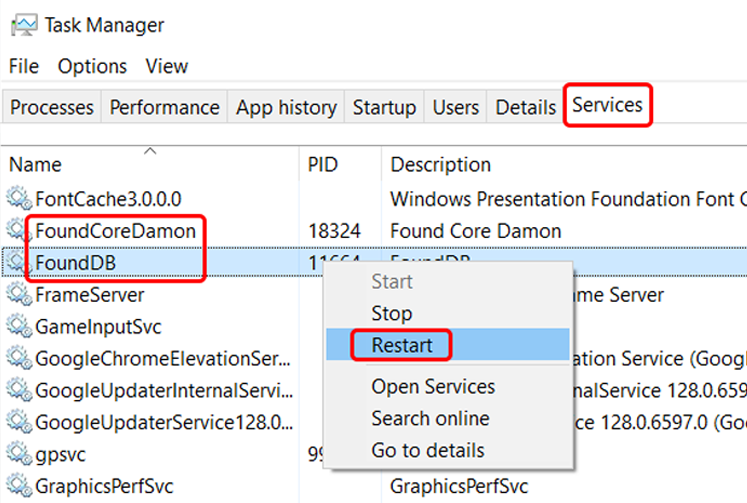
16.4 Why does Found require an internet connection?
A: Found uses grey-box testing to collect runtime data and detect potential bugs, as well as to acquire and switch user account types in real-time. The collected data is only related to the software's functional status and not to local files. We have a strict privacy policy (aalab.com/privacy-policy) and fully comply with it. Pro users can work offline with Found for 7 days without a stable network connection (regular users can use it offline for 3 days). If you are a team leader or enterprise, and need an offline solution or advanced customization, please send an email to hello@aalab.com.
16.5 Where is Found's database stored? Will using Found take up a lot of disk space on my computer? Can I customize the storage path?
A: Found's default database cache path is C:\ProgramData\Aalab\Found2. Unlike most asset management software that imports and backs up duplicate files, Found does not take up extra disk space. For collection management, it only uses a "shortcut" concept, meaning your source files remain in their original locations and are not duplicated. The database cache will also be automatically released when it exceeds its limit. To ensure Found functions properly, we currently do not allow custom database paths.
16.6 Why does Found's program remain in the background after exiting?
A: Due to the nature of Found software, it needs to synchronize folder changes. Therefore, even after the client exits, a background program remains resident. This program barely uses any computer resources and performs no actions when no folder changes are being made, so please use it with peace of mind.
16.7 Why can't I find my NAS server on the local network using Found?
A: Please check if your NAS configuration is normal. For the first installation of Found, you need to re-enter access credentials. You can find your NAS by opening "Network" in Found's directory panel.
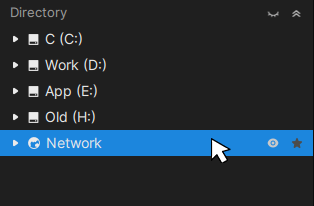
16.8 How do I modify the setting to minimize Found to the system tray on exit?
A: While the Found client is closed, you can find the "Found2.ini" file in "Documents\Found2". Open it with Notepad, change the parameter after minimize_to_tray = to 0, save and close the file. When you restart Found and then close the window again, it will prompt you whether you want to exit or minimize to the system tray.
16.9 Installation successful but unable to open the interface, nothing displayed?
A: Currently, a very small number of users have encountered this issue. If you experience this problem, please contact us directly.
16.10 Why does the preview screen show jagged edges and unclear images/videos?
A: This phenomenon is very rare, and we are currently working to eliminate related issues. Usually, simply exiting Found and reopening it will resolve the problem.
16.11 Why are my sequence frames not merged and displayed?
A: By default, Found only supports sequence frame naming that adheres to industry standards, meaning the frame numbers in the file need to be separated from other characters by a period "." or underscore "_", and the frame number length must be consistent, with a minimum of 4 digits. For example, "ABC.0001.jpg" or "ABC_0001.jpg" will be recognized as a sequence frame. If you are a Pro user, we recommend changing the sequence frame recognition to "Loose mode" in the settings panel, which will recognize most non-standard named sequence frames with more lenient rules.
16.12 How to initialize Found's interface and all parameters?
A: Please ensure Found is closed, then directly delete the "Documents\Found2" folder. Note that this operation will reset Found (the database will be preserved), and all interface-related preferences and option parameters will be restored to their initial state.
17. Installation Issues
We apologize for any installation problems you may have encountered. Found is a software maintained and developed by a small team of professional designers, and facing a large number of users with different system environments, there might be areas where we overlooked. Below is a summary of common issues users frequently encounter, hoping to help you resolve your situation. If you try these solutions and still cannot resolve the issue, please package all log files from C:\ProgramData\Aalab\logs and send them to support@aalab.com to get in touch with us.
17.1 What should I do if an error occurs during Found installation?
A: Please try restarting your computer and then right-click the Found installer and choose "Run as administrator". If it still fails, locate the installation path you selected (default is C:\Program Files\Aalab), right-click the folder → Properties → Security, and check if your current user account has full control. If not, click Edit to grant full control, then try installing again. If it still doesn’t work, try running Command Prompt or PowerShell as administrator, and enter the following command: sfc /scannow This will scan and repair protected system files. Once finished, restart your computer and try the installation again.
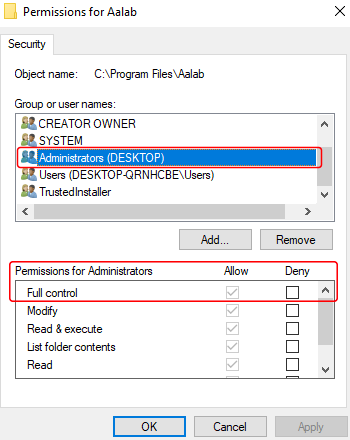
17.2 How to handle security software prompts during Found installation?
A: Due to Found's need to access and modify different user folders and their contents, some security software may falsely report it. In such cases, please choose to trust it and add it to the whitelist. Found always protects user privacy and will not proactively request or obtain user data without explicit consent.
17.3 Installation successful but unable to open the interface, nothing displayed?
A: A very small number of users have reported this issue. If you encounter this problem, please contact us directly at support@aalab.com.
17.4 The installation process is slow and takes a long time, how to solve it?
If the installation path is on a hard drive (HDD), it may take up to 8 minutes to complete. We recommend installing Found on an SSD for faster performance. If the issue persists, please contact us at: support@aalab.co